Content
- 1 Garden hydrangea - species and varieties
- 2 Growing features
- 3 Landing in open ground
- 4 Phantom hydrangea care
- 5 Protection against diseases and pests
- 6 Use in landscape design
- 7 Hydrangea planting rules
- 8 Basic rules for caring for hydrangea
- 9 Propagation of hydrangea
- 10 Popular types of hydrangea
- 10.1 Large-leaved hydrangea (Hydrangea macrophylla)
- 10.2 Hydrangea paniculata (Hydrangea paniculata)
- 10.3 Stalked hydrangea (Hydrangea petiolaris)
- 10.4 Hydrangea tree (Hydrangea arborescens)
- 10.5 Ground cover hydrangea (Hydrangea heteromalla)
- 10.6 Recommendations for planting and caring for hydrangea in the garden - video
Planting garden hydrangeas and care have their own characteristics. To admire the beautiful and lush flowering, we will learn how to properly care for this plant.
Garden hydrangea - species and varieties
There are many types and varieties of this ornamental shrub. Most of them prefer to grow in partial shade, but there are some that do well in sunny areas. The height of the bushes and the flowering period are very different and depend on the variety.
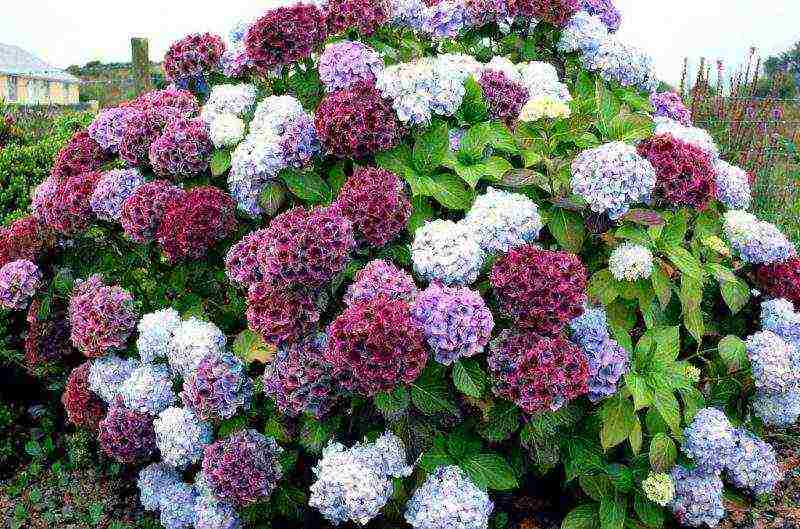
The most common types:
- Large-leaved. It blooms in the second half of summer with lush inflorescences in the form of balls. Flowers can have a different shade. Height - 2 m.Requires shelter in winter, maximum tolerates temperatures up to - 10 ° C
- Pereshkovaya. Variety of creepers. It blooms with white-pink inflorescences. Requires support, otherwise it will creep along the ground. A good option for arbors and arches.
- Tree-like. The flowers are snow-white. Height - up to 3 m. It looks very impressive, but freezes in winter. The plus is that the plant recovers quickly. Requires strong spring pruning.
- Paniculata. It blooms from July to late autumn with dense panicles 30 cm long. The shade of the inflorescences varies from white to greenish. The height of the bush is 3-4 m. An unpretentious and frost-resistant variety.
On the basis of these species, many different varieties have been created, each of which is beautiful in its own way. Depending on the type, hydrangeas can be deciduous or evergreen, but in our area they are most often grown in the first version.
Growing features
Interestingly, the shade of the inflorescences can be adjusted independently by adding certain fertilizers to the soil. On neutral soil, the flowers will have a beige or cream shade. A soil with a high alkali content gives flowers a pink or lilac color, acids - a blue one.
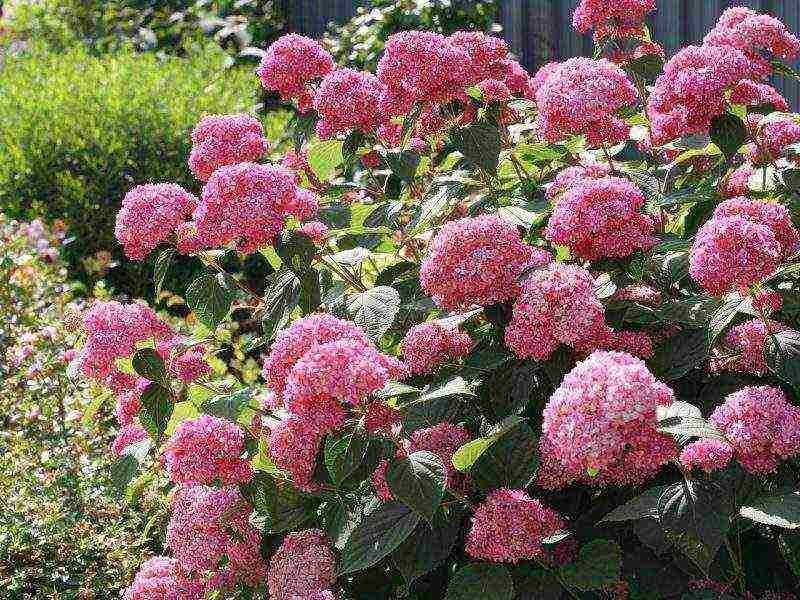
Bright lighting is very important for the shrub, but the scorching rays of the sun are destructive for it, as well as deep shadow. Therefore, it is best to plant a flower where there is shade at lunchtime, and the rest of the time - the sun.
It is important not to overfeed the seedlings with organic matter. They will grow green mass, but are unlikely to bloom.
Landing in open ground
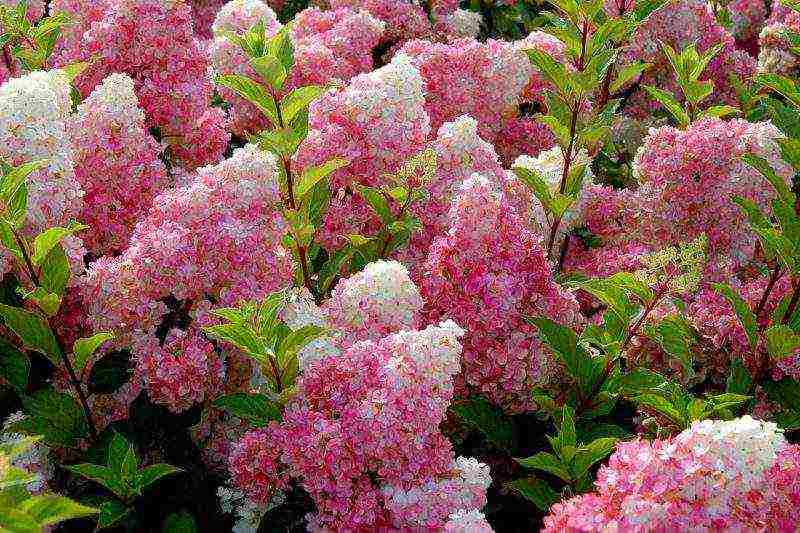
Hydrangea is a demanding flower. Therefore, before landing, you need to think carefully about all the nuances.
Site and soil preparation
The landing site must be prepared in advance - about 2 weeks in advance. The soil should be acidic and well moisturized. Acidity can be adjusted independently with the help of special preparations. Depending on the variety, the flowers can grow in partial shade or in the sun. The best place for planting is light partial shade; in a strong shade, the plants will not bloom.
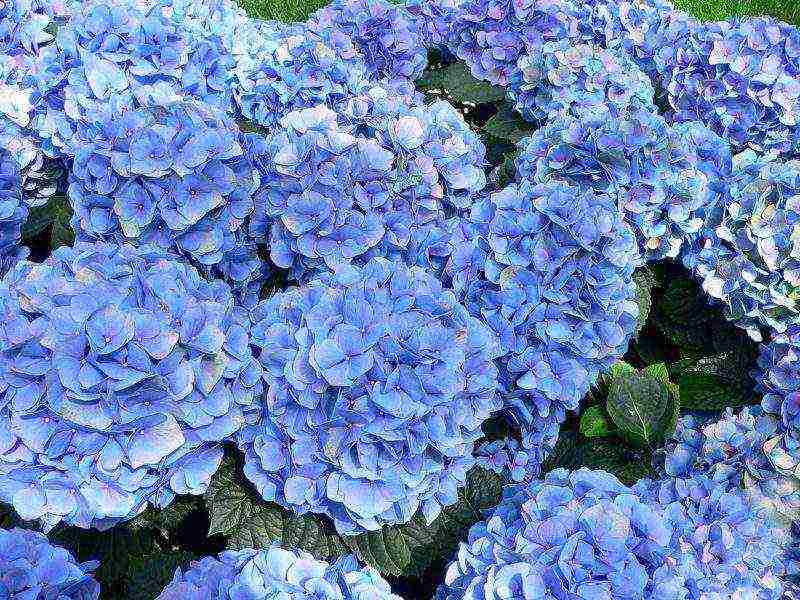
The hole should be small: 40 cm deep and 40 cm wide. If a group planting is planned, then the distance between the bushes should be at least 90-100 cm. Sand and fertilizers are added to the pit, mixing well with the ground. The next layer is poured a little peat.
How and when to plant?
Planting is done in early spring or autumn.It depends on the climate of each region. In cold areas, it is better to plant the bushes in the spring so that they can give new roots, get stronger and be able to survive the harsh winter. In warmer regions, planting can be done in the fall. If planting is done in spring, then annual shoots should be shortened by at least 3 buds.
It is advisable to shorten the roots of the seedling a little. When planting, you need to ensure that the root collar is not covered with earth. The planted bush is abundantly watered and mulched with peat. When watering, care must be taken that a strong jet of water does not erode the soil near the roots.
As soon as new leaves appear on the plant, this indicates that the process of the formation of new roots is in full swing.
Phantom hydrangea care
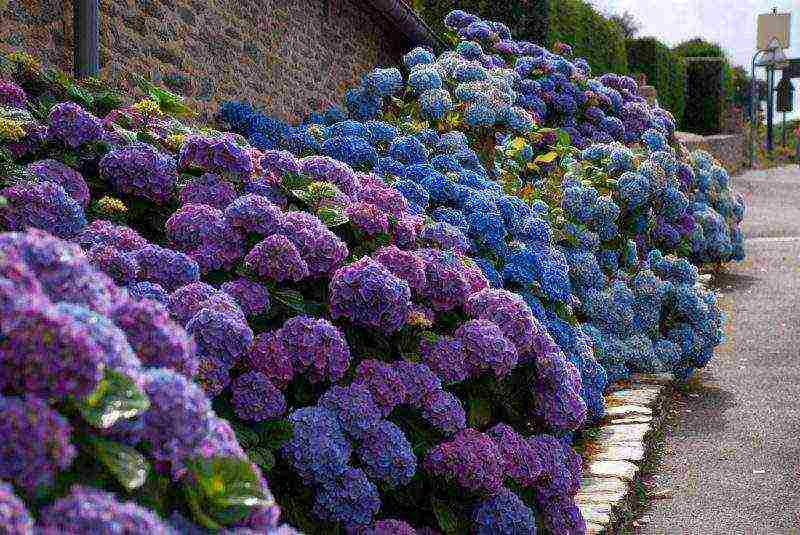
Hydrangea Phantom is one of the most beautiful of the paniculata family. It blooms magnificently throughout the season with long panicles and exudes a pleasant aroma. The variety is resistant to root diseases and frost, quickly recovers after freezing. The bush can grow in one place for many years without requiring a transplant.
Watering and feeding
"Hydrangea" translated from Latin means "yearning for water." The flower is very hygrophilous, therefore, in no case should the soil dry out. Watering should be regular and abundant. As soon as the topsoil dries up a little, the plant needs to be watered again. If the ground around the bush is mulched with peat, you can water less often, since the soil does not dry out so quickly. In the first years, 7-8 liters of water are poured under each seedling, in subsequent years - at least 18 liters.
Watering is the best time to feed. In early spring, the plant needs nitrogen fertilization, during the budding period - in potassium and phosphorus.
It is useful to water the bushes with acidified water once every 2 weeks. For 10 liters of water, you need to take 1 tbsp. l. citric acid. The solution is poured directly under the roots. In addition, in the spring-summer period, once every 3-4 weeks, you need to loosen the ground in order to improve aeration.
How to transplant and prune?
The plant tolerates pruning well. If you do not cut it, the bush will lose its decorative effect, and the flowering will be weak. It is best to do this procedure in the spring, when the buds are swollen. If the bushes are too old, they can be easily renewed by cutting them almost to the root.
All types of hydrangeas can be divided into two groups:
- To the first category includes those species and varieties, the flowers of which are formed on the shoots of the last year (petiole, prickly, large-leaved, serrate). They do not need special pruning, it is enough to remove old, dried and improperly growing branches.
- To the second category includes species that form flowers on the shoots of the current year (paniculate and tree-like). These bushes require strong pruning, all shoots should be shortened in early spring to 2-3 pairs of buds.
When the hydrangea is going to bloom for the first time, you need to immediately cut off all the buds so that the plant gains strength and can bloom profusely next year. Formative pruning of the bush within 5 years will produce a beautiful little tree.
It is necessary to transplant Phantom hydrangea only in extreme cases. It grows well in the same place for years. Therefore, transplanting is justified if an adult bush needs to be divided into parts and planted in other places.
Flower care in autumn
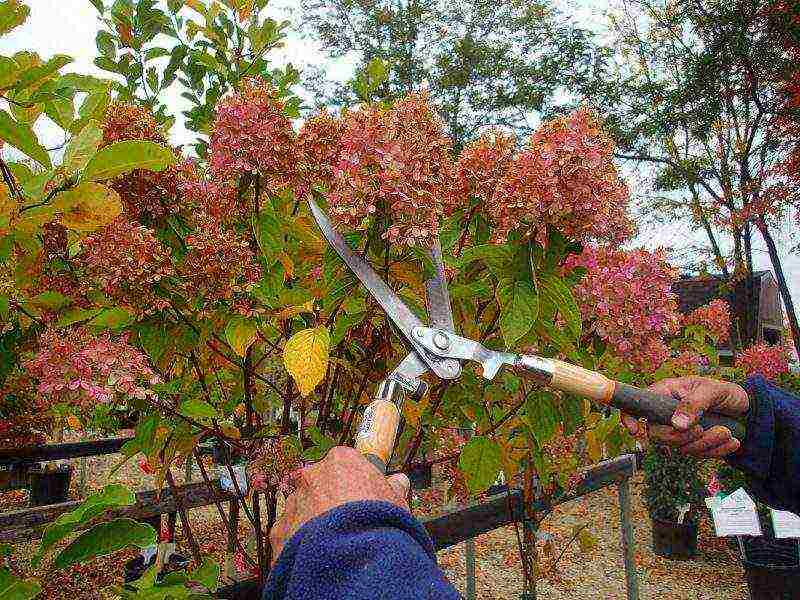
Caring for a garden hydrangea in autumn consists in pruning the inflorescences, while removing at least 3 buds from the top of the shoot. This must be done so that suddenly falling wet snow does not freeze on them and break fragile branches. The base of the bushes must be highlighted, and the ground around them must be well mulched. This will protect the superficial root system from frost.
How does hydrangea winter?
In the middle lane, the shrub tolerates winter well. But for a safety net, it is still better to cover it with spruce branches. In the northern regions, the flower is taken to a room with a positive temperature for the winter, since severe frosts can destroy it.
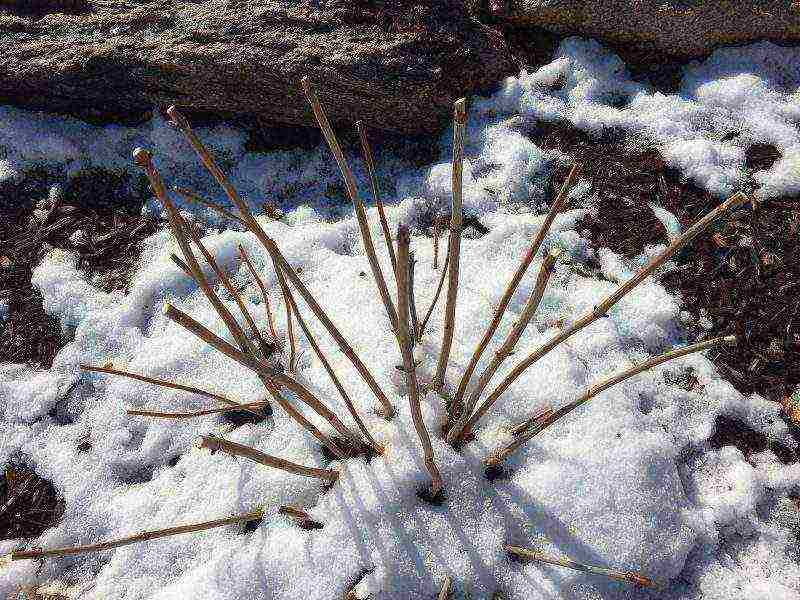
Sometimes the bushes are neatly tied, wrapped in spunbond and a mesh frame is erected near them. The space between the covering material and the mesh is filled with dry foliage. With the first breeze of heat, the leaves are removed, but the spunbond is removed only after a constant positive temperature is established.
How does garden hydrangea reproduce?
The easiest way to propagate a hydrangea is cuttings. They are cut in the spring from annual green shoots. It is necessary to cut at right angles. The length of the cuttings is no more than 12 cm. Leaves are removed from the bottom, treated with preparations to stimulate growth and planted in a greenhouse or boxes.
A good option is to multiply the flower by dividing it. This can be done both in spring and autumn. The bush is carefully dug up and divided into 3-4 parts, so that each one has several renewal buds. The workpieces are planted in pre-marked places.
Also, without much effort, you can propagate the hydrangea by layering. Young shoots are gently bent to the ground, fixed and buried in the ground, leaving the top (about 20 cm). As early as the next spring or autumn, the root cuttings can be separated from the mother plant and transplanted.
Sometimes the shrub is propagated by seeds or grafting, but these are too laborious methods. Knowing how the garden hydrangea reproduces, you can choose the appropriate method in advance and do it in a timely manner.
Protection against diseases and pests
Hydrangeas rarely get sick, while the lion's share of the disease is transferred with seedlings. For this reason, you only need to buy new plants from proven nurseries. Other causes of diseases are called plantings thickening, lack of nutrients and high air humidity.
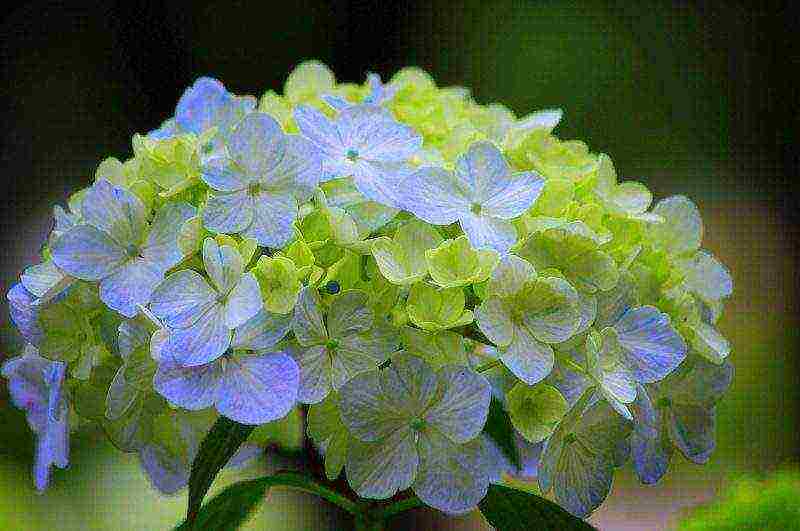
Many fungal diseases can be fought with copper oxychloride.
One of the most common diseases is chlorosis. Due to the lack of iron, the leaves turn yellow, while the veins remain green. For treatment, drugs Agricol, Brexil are used. As a preventive measure, plants need to be fed with iron-containing fertilizers in a timely manner.
Use in landscape design
Hydrangea looks great both in single plantings and in group plantings. You just need to design in advance its location at a decent distance from other plants. Over time, the bushes grow strongly and require a lot of space.
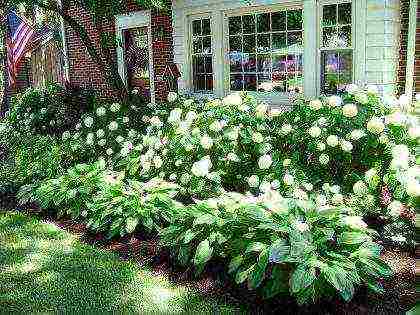
The flower can be planted as a soloist in the front garden if it is located on the north side of the house. When choosing hydrangea companions in a mixborder, you need to take into account their features. Similar requirements for moisture, lighting and soil acidity in astilba, hosts, cuffs. If the site is large, you can plant a composition of several bushes. Their sprawling shape will create an expressive accent in the garden. These shrubs are often used to restrict areas of the garden.
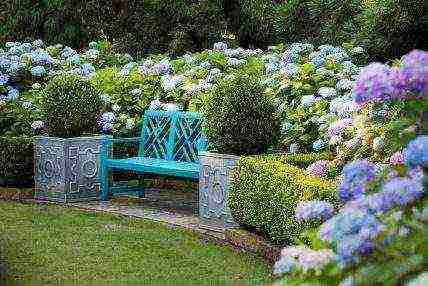
Hydrangeas work well with a variety of garden styles, so anyone can grow them.
Hydrangeas are very popular as garden plants. Still: luxurious balls of small flowers that will decorate any garden will not leave anyone indifferent. However, without proper care, the hydrangea is unlikely to bloom. The beauty is demanding on the acidity and structure of the soil, on top dressing, watering and the place of growth.
Given the variety of hydrangea
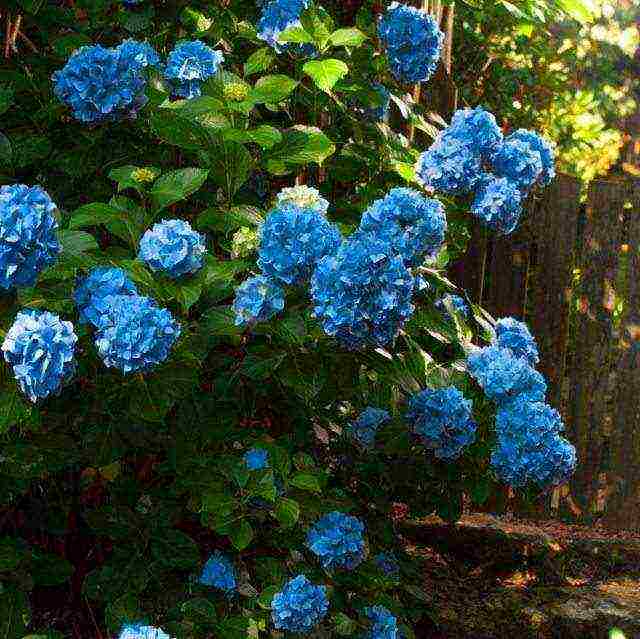
The variety of hydrangea varieties is very large. Different varieties differ in the shape of the flowers and, most importantly, in their needs, which is important to consider when buying. All hydrangeas are quite capricious. But the most adapted to life in our gardens are panicle and tree hydrangea. They tolerate frost and excessive heat more easily than others.
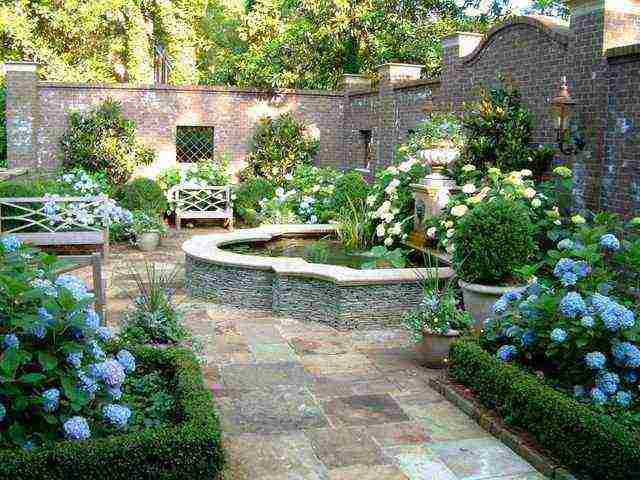
Among the panicle hydrangea, more frost-resistant varieties are distinguished and those that need mandatory shelter for the winter. Uncovering hydrangeas bloom on the branches of the first year. Garden hydrangeas (macrophila) are distinguished by abundant continuous flowering. Moreover, the flowers change their color during the ripening process.Therefore, the bushes simultaneously present flowers of various shades of blue and pink.
READ ALSO: Climbing roses - planting and care
Garden hydrangea: planting in open ground
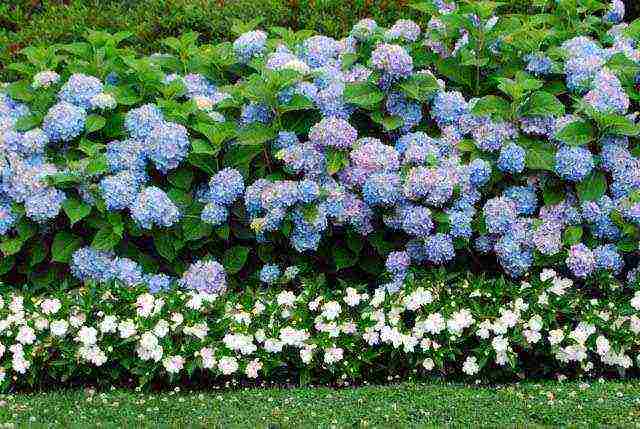
As a rule, hydrangeas are purchased in nurseries. There, the bushes are kept in ideal conditions, using drip irrigation with the obligatory addition of fertilizers to the water. After transplanting such plants into the garden, problems may arise: the bush begins to ache, wither and does not want to build up a secondary root system. Therefore, every gardener has a responsible task to provide the plant with painless adaptation.
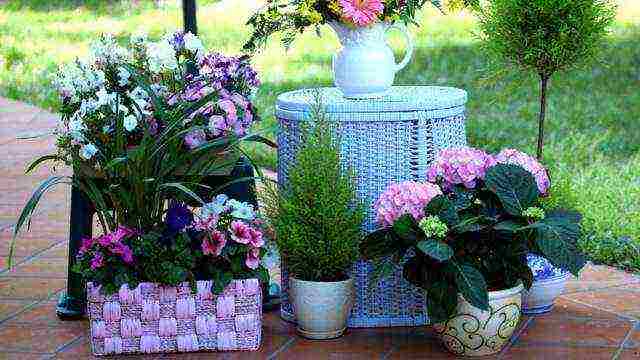
Hydrangea prefers loose and acidic soil. For planting hydrangeas, soil is used, consisting of a ready-made soil mixture, leafy earth and sand. The planting pit should be about 50 cm deep and 40-50 cm in diameter. At the bottom of the pit, in order to avoid sudden changes, the fertile soil is mixed with the ground. Do not shake off the soil and straighten the roots from the plant removed from the container. It is better to leave the clod of earth as it is. After planting, the plants are mulched with bark or pine needles. This will allow maintaining the looseness, moisture and acidity of the soil at the proper level.
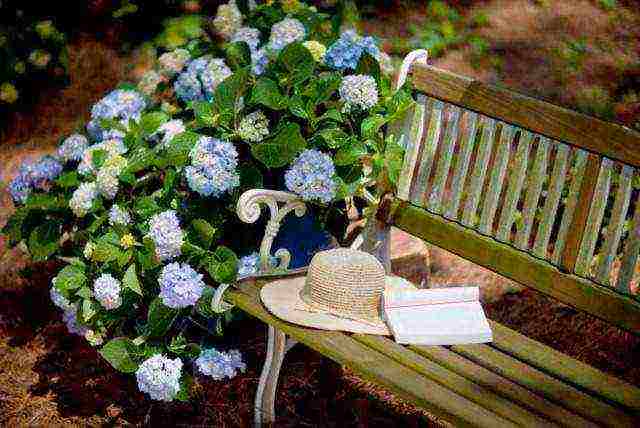
Most hydrangea varieties bloom well in partial shade, protected from the wind. Loose, humus-rich soil and the correct watering regime are of great importance for the plant: the roots of the hydrangea should not be allowed to dry out. In general, the shrub is very demanding for watering.
Feeding hydrangeas
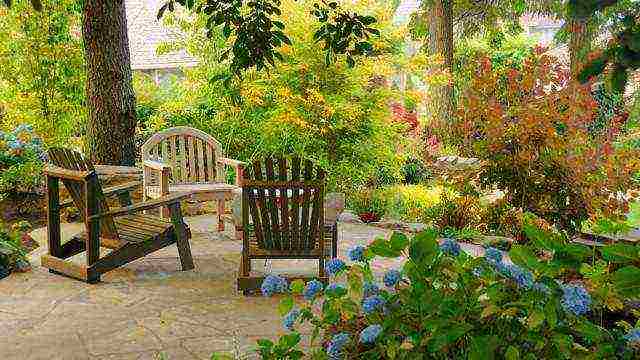
Top dressing is a prerequisite for caring for a hydrangea. Immediately after planting for two months, the hydrangea must be fed every two weeks. Thus, it is "weaned" from the large amounts of nutrients in the soil.
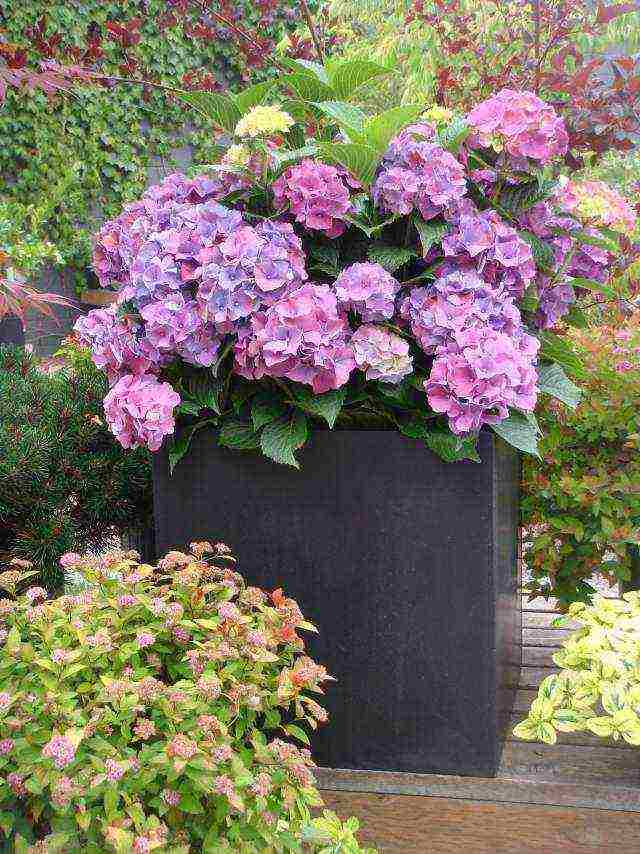
Further, the plant is fed in the spring during the budding period and during the bud formation period. After flowering, the hydrangea is fed several more times. This is necessary for the full-fledged laying of flowering buds for the next year and the successful wintering of the plant.
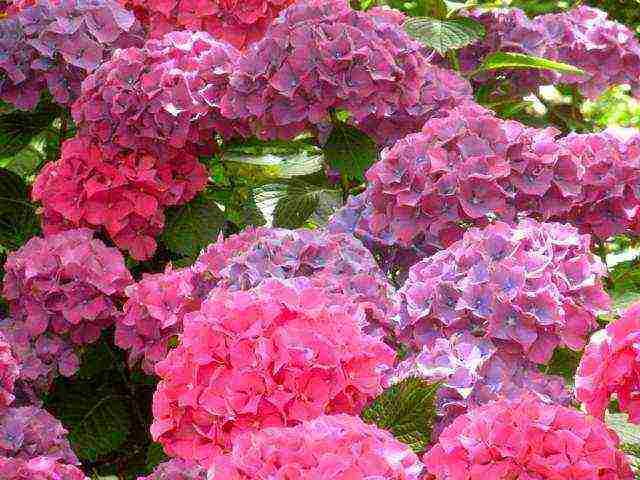
To feed hydrangeas, complex fertilizers are used for flowering plants growing on acidic soils (azaleas, magnolias, orchids). It acidifies and fertilizes the soil well with rotted manure. But when used in large quantities, the bushes grow too large inflorescences, and the branches can break under their weight. To strengthen the shoots, you can water the plants with a solution of potassium permanganate.
READ ALSO: Pergola to (almost) hide you from the sun
Pruning hydrangea
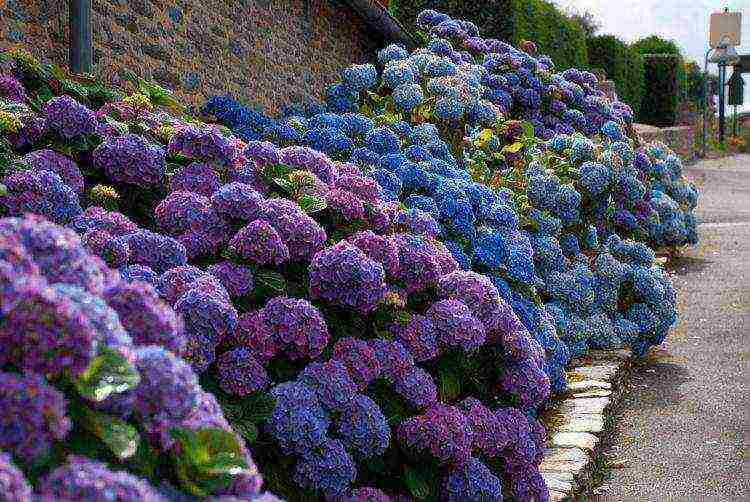
Whether or not a hydrangea needs to be pruned depends primarily on the variety. In large-leaved hydrangea and serrata hydrangea, it is only necessary to prune frozen shoots after winter, the plant will not tolerate radical transformations. The fact is that hydrangeas of these varieties form buds in the fall the next year.
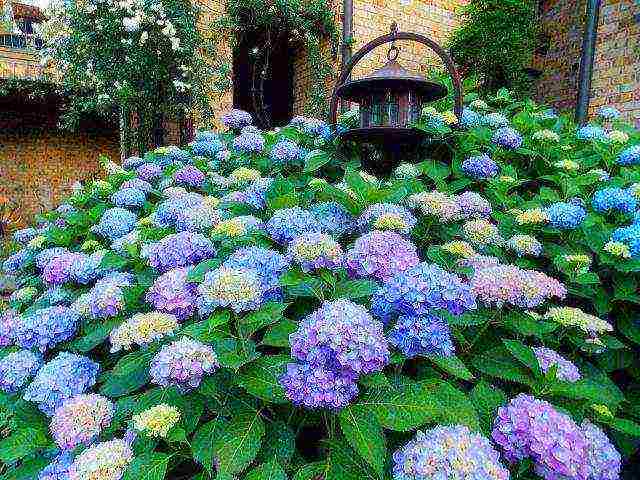
But hydrangea paniculata, hydrangea tree-like (anabel) and hydrangea oakleaf can withstand radical pruning in the fall. But it is still better to cut off a little than a lot, otherwise you risk that your hydrangeas will not bloom in the spring.
Hydrangea color as custom
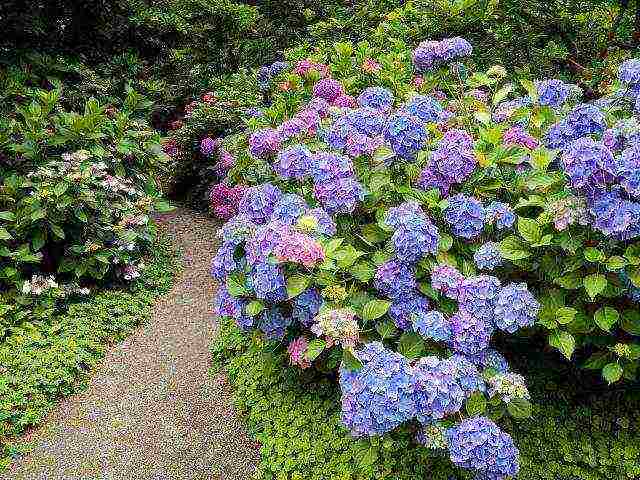
Hydrangea has an amazing feature: the plant changes color of flowers depending on the composition of the soil. White flowers can turn pink and pink flowers turn blue. How can this be achieved? Knowing that flowers turn blue in acidic soil, and pink in neutral soil, you can independently influence the color variety of your garden. The ideal time for this is early spring, shortly before the buds open. To independently influence the flowering, it is necessary to bury rusty nails under the bush or water the soil before flowering with aluminum alum (5g / l of water).
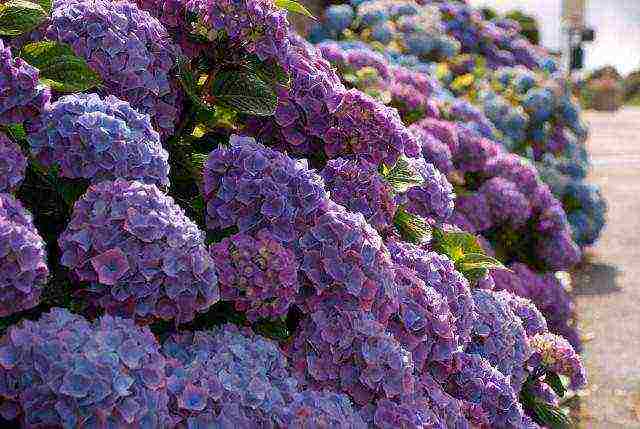
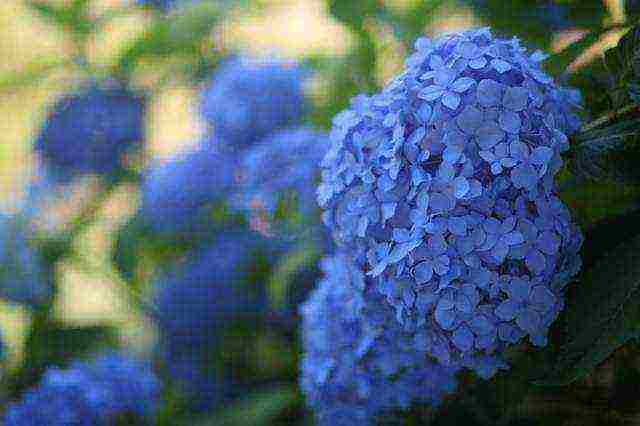
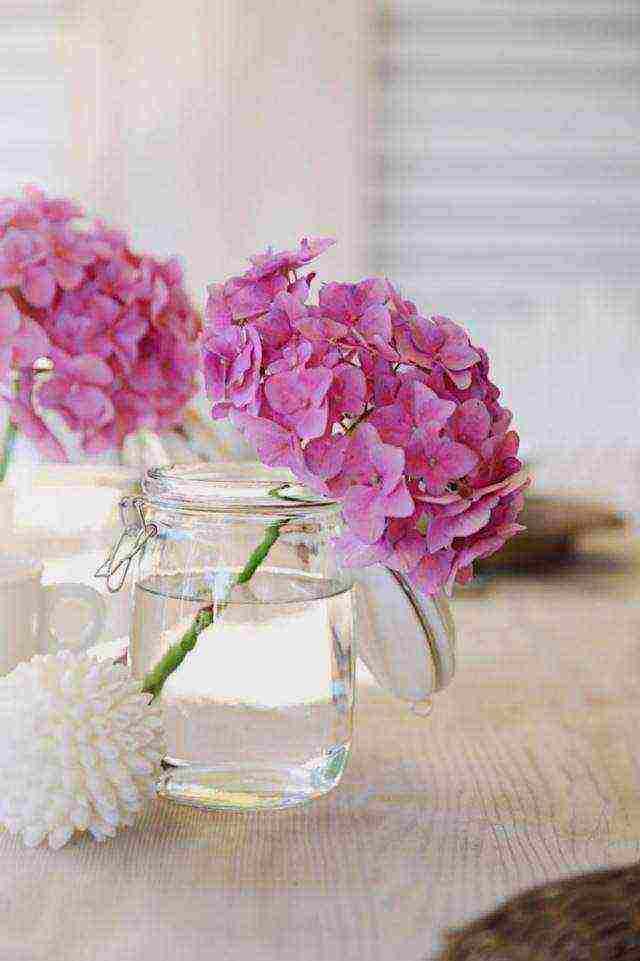
Cut hydrangea flowers will be a beautiful bright accent in your home. And even when the magnificent flowering is waning, hang the inflorescence with the stem up and let it dry. Dry hydrangea heads will serve as an excellent addition to the autumn decoration of the house.
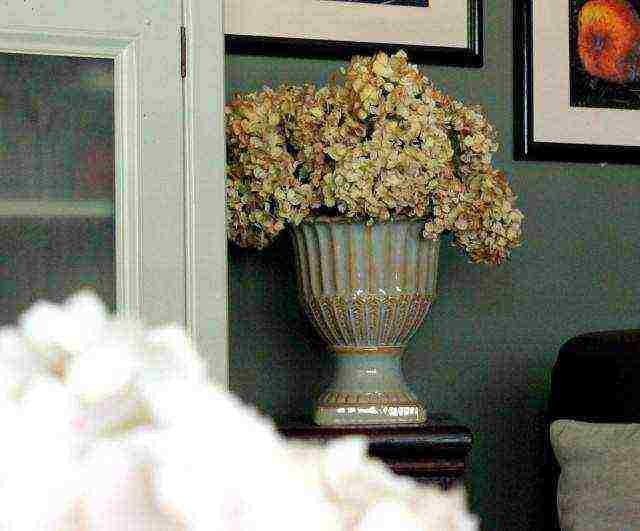
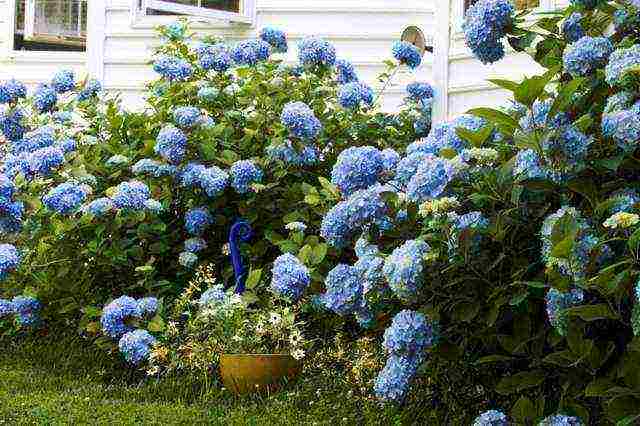
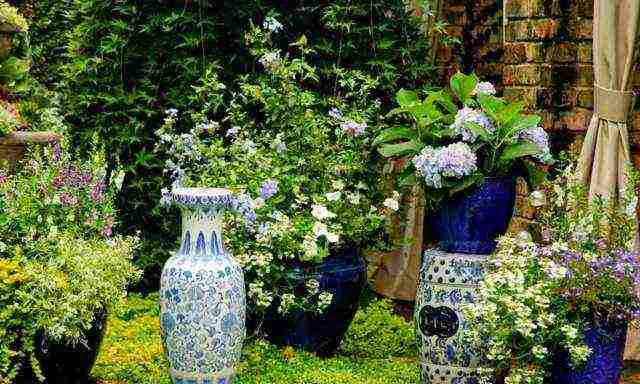
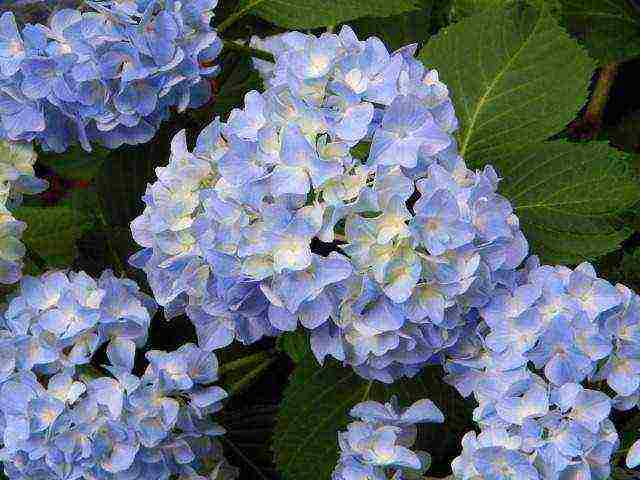
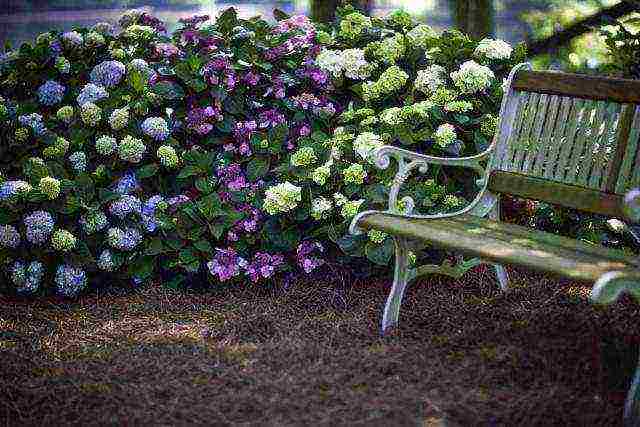

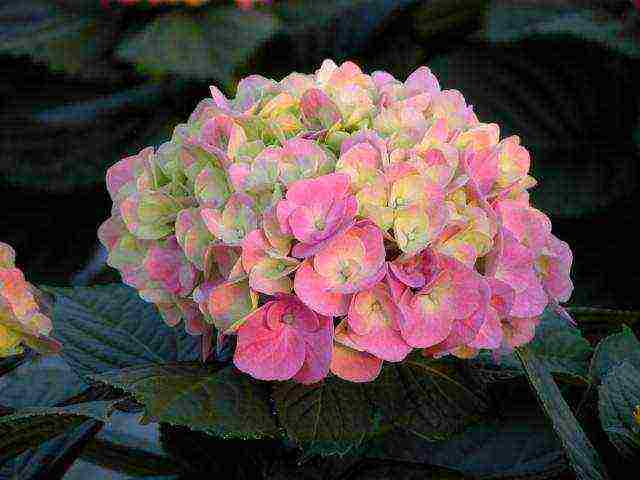
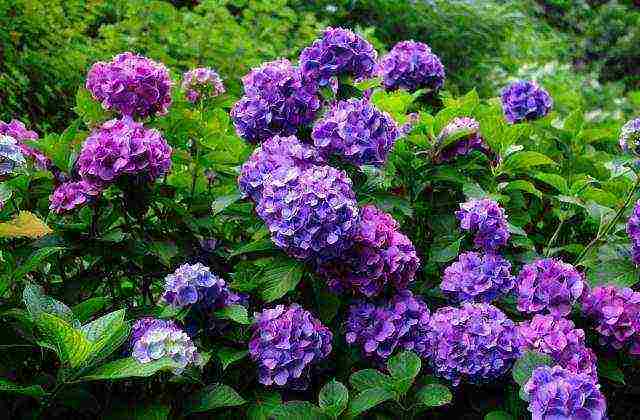
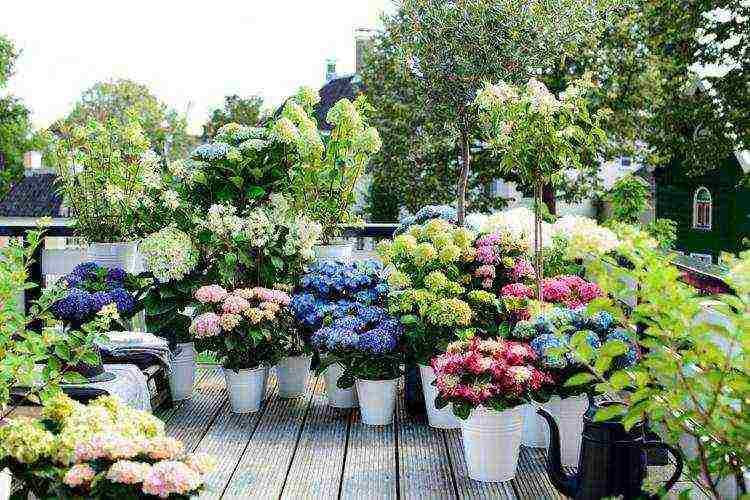
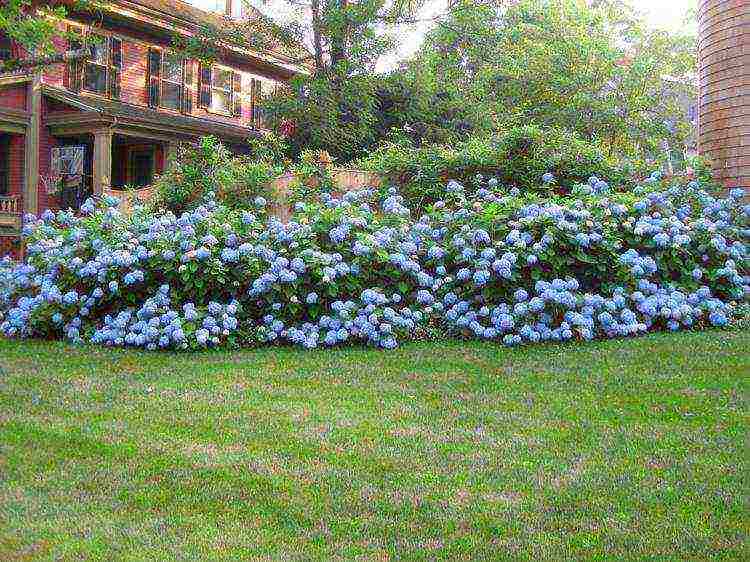
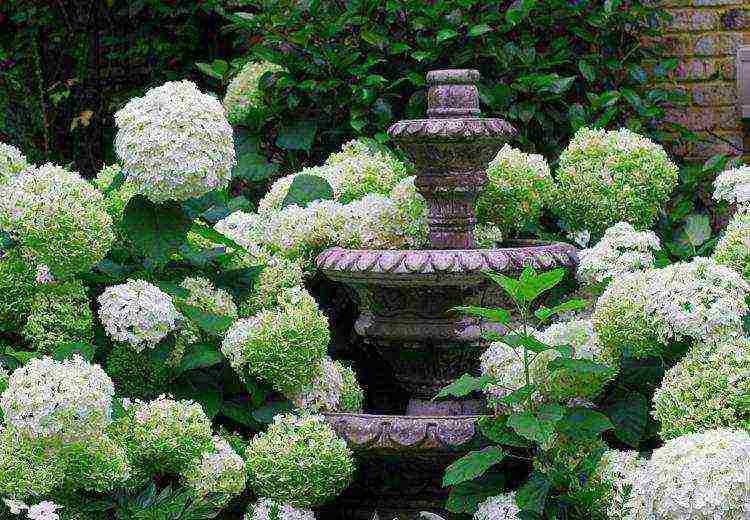
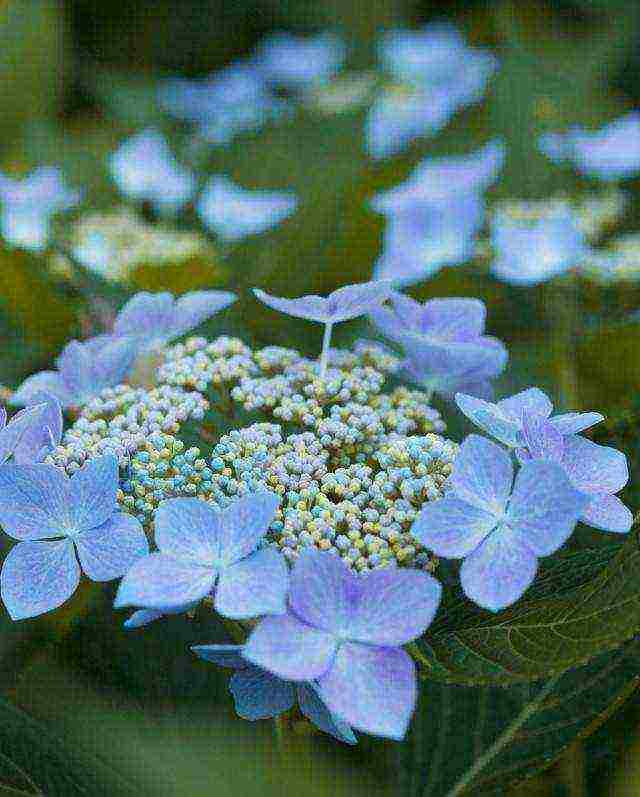
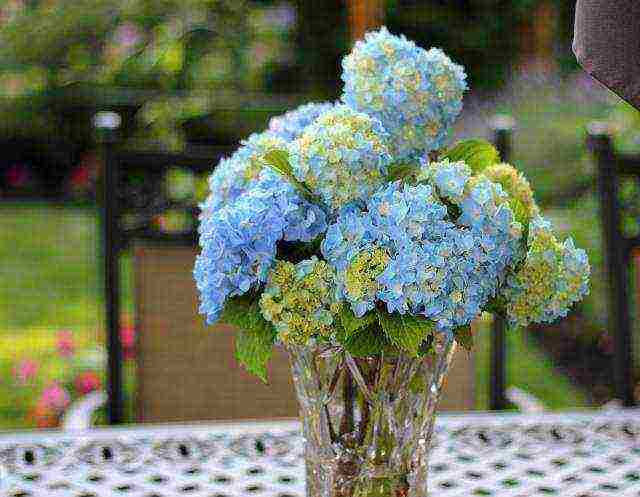
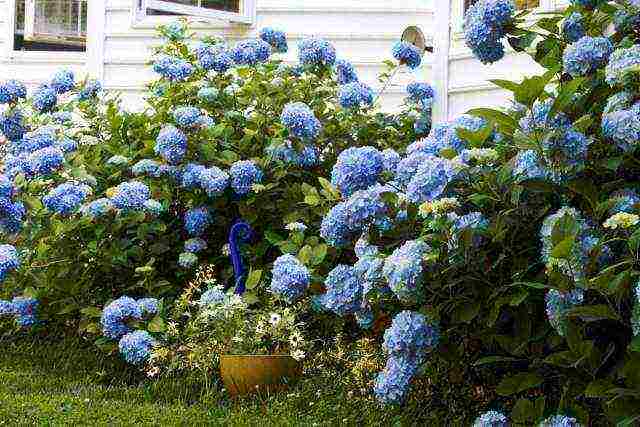
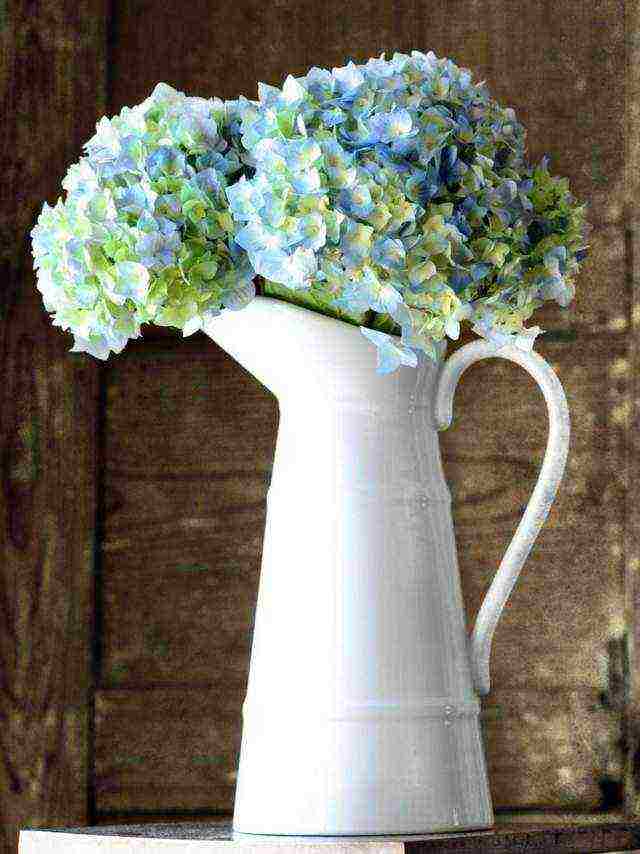
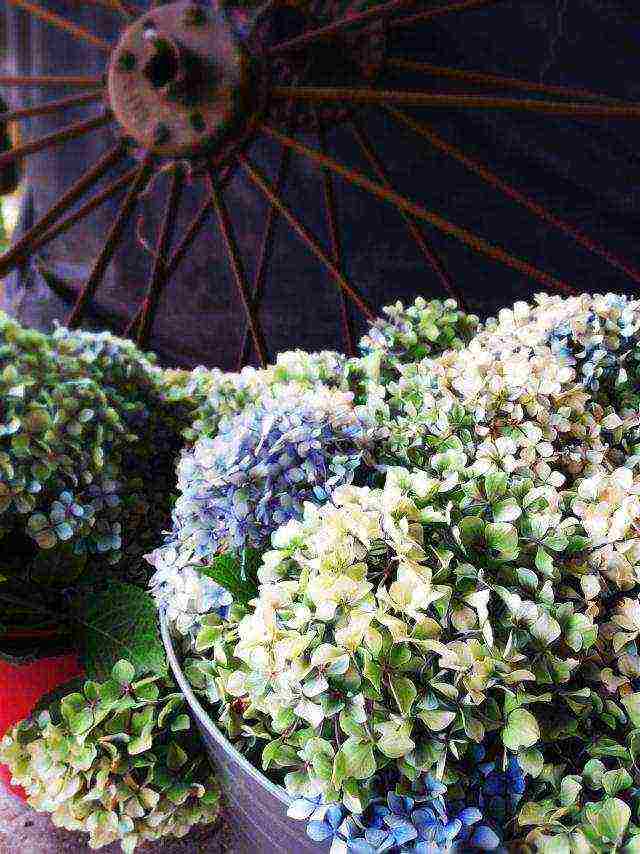
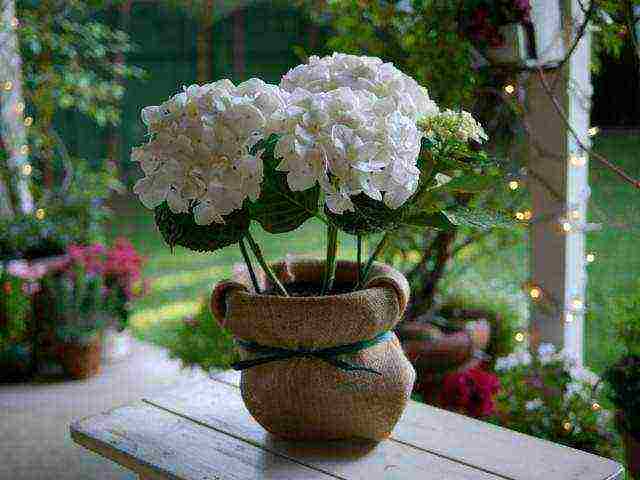
Photo:
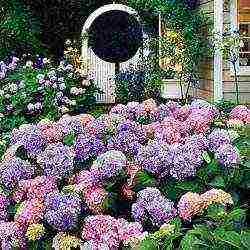 Do you want to decorate your garden with an unusual shrub? Try planting a hydrangea flower, planting and caring for which in the open field is simple, reproduction and growing of hydrangea is possible even for novice gardeners. You can find a fantastically beautiful flower by reading the description of the variety and considering its combination with other plants in landscape design. In the photo, the hydrangea looks like the queen of the garden.
Do you want to decorate your garden with an unusual shrub? Try planting a hydrangea flower, planting and caring for which in the open field is simple, reproduction and growing of hydrangea is possible even for novice gardeners. You can find a fantastically beautiful flower by reading the description of the variety and considering its combination with other plants in landscape design. In the photo, the hydrangea looks like the queen of the garden.
Varieties and varieties of hydrangea
Hydrangea is an undoubted favorite among flowers in summer cottages. A long flowering period, a variety of shapes and tones attract special attention to it from gardeners and designers; more and more often, various varieties of this perennial are used in landscape design.
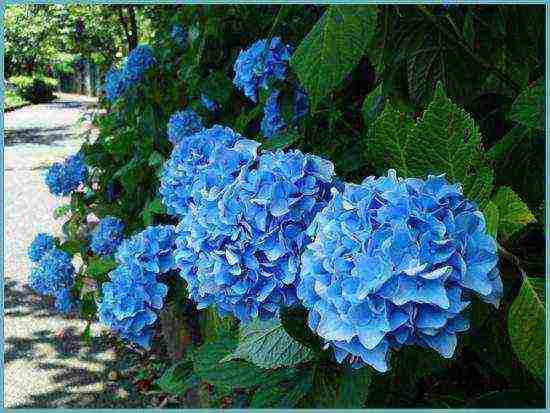
Blue hydrangea
Hydrangeas can be spherical, racemose, and white, lilac, red, two-colored in color. The most common in our latitudes is the tree hydrangea. Unpretentious, fairly easy to care for and grow, the plant is recommended for novice gardeners. Several varieties of shrubs have been bred by breeders:
- Bella Anna - a new variety of tree hydrangea, has rather large spherical inflorescences, the crown grows up to three meters in diameter, the color of the petals is from pale pink to purple-pink, blooms throughout the summer season and September;
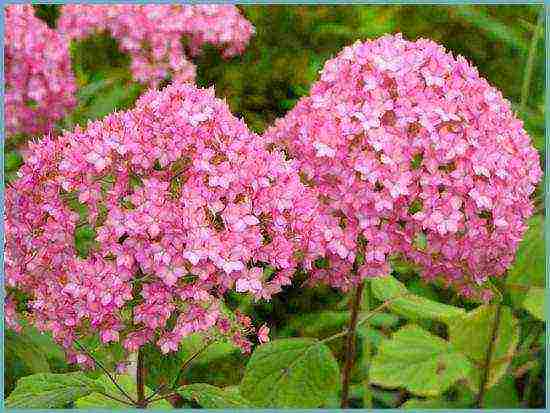
Bella Anna variety
- "Anabel" - a lush blooming, spreading shrub about 1.5 m high, inflorescences in the form of a ball of snow-white color, blooms in early July and retains its color throughout the summer season until September. After the end of flowering, the leaves of the plant remain bright green throughout the fall. Variety "Anabel" is adapted for wintering, does not require special shelter for the winter, frost-resistant;
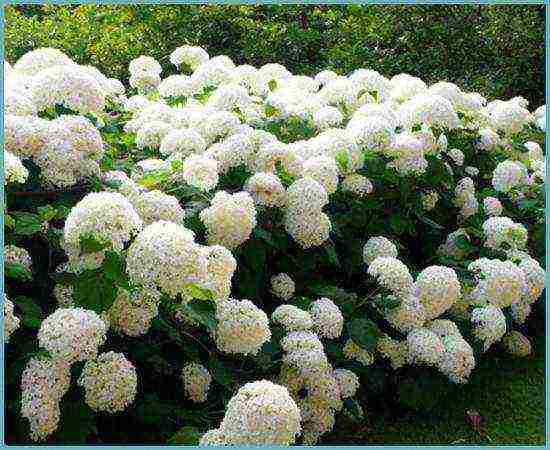
"Anabel"
- "Grandiflora" - differs in large crystal-white inflorescences, blooms for 4 months;
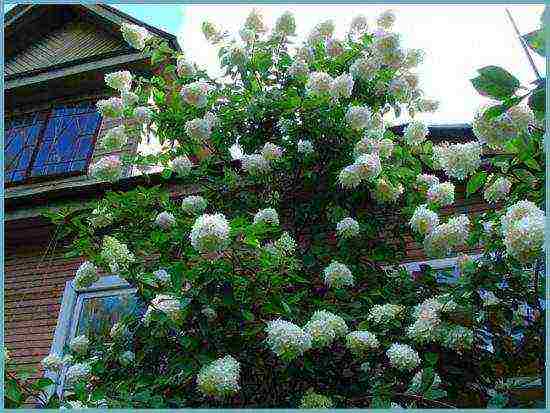
"Grandiflora"
- "Invincibel Spirit" - a new variety of hydrangea with pink petals;
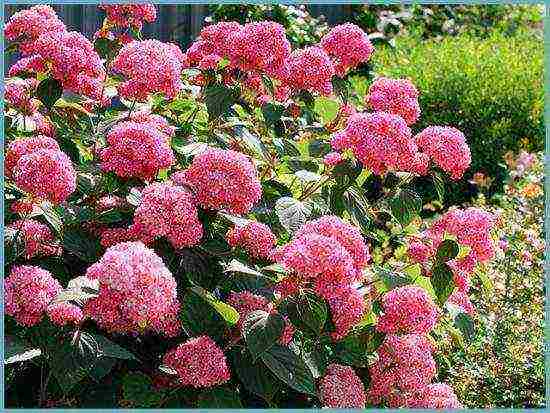
"Invisibel Spirit"
- "Sterilis" - a variety with hemispherical, dense, heavy inflorescences, during the flowering period - from July to October - the petals radically change color: from pale green to crystal white.
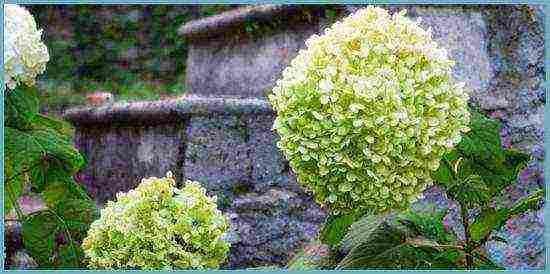
"Sterilis"
Also, a fairly common perennial variety - Panicle hydrangea, planting and caring for which is quite simple. This flower is attractive with inflorescences of an unusual - paniculate - shape, frost-resistant, characterized by rapid recovery even in unfavorable climatic conditions. An interesting feature of this hydrangea variety is the particularly long flowering period, during which the inflorescence changes its color. Does not need mulching for the winter. The most common varieties of panicle hydrangea are:
- Vanilla Fraze - variety with pale white and pink petals;
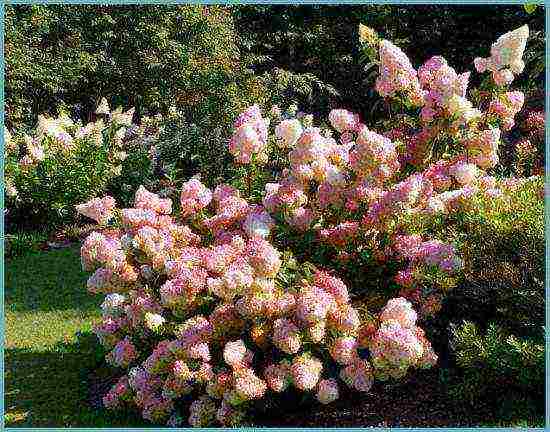
"Vanilla Fries"
- "Limelight" - the plant blooms in autumn, differs in large inflorescences of a pale lemon shade;
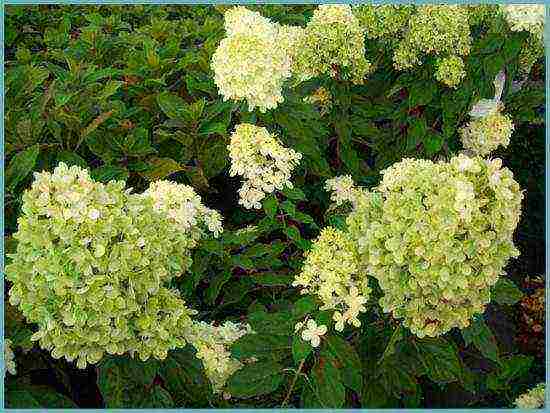
"Limelight"
- "Pinky Winky" - hydrangea with soft red petals.
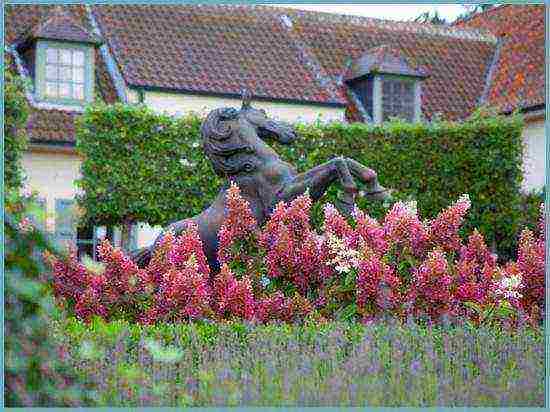
"Pinky Winky"
How to plant correctly
Growing hydrangeas in the open field is possible even for novice gardeners. If a hydrangea is chosen for a flower garden, planting and caring for it will never be a burden, they will become favorite activities. The correct location should be chosen for planting the shrub. Hydrangea does not tolerate long shading, the best place to plant it is on the sunny side. Hydrangea propagation is carried out by separate bushes or cuttings. It is recommended to plant a flower in spring (in May) or in autumn (in warm September).
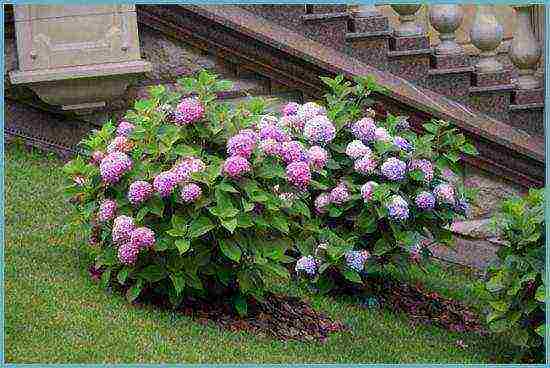
Even a novice gardener can plant a hydrangea.
To plant a hydrangea with a bush in the open field, you need to dig a planting hole about 60 cm deep, about half a meter wide and long. The distance between the bushes is at least 1.5 meters. A flower, growing with proper care, will occupy a much larger area than when planted.The pits should be filled with a special mixture, including peat, sand, soil, humus (1: 1: 2: 2) and fertilizers (landscape design experts recommend combining 20 g of urea, potassium sulphide each, add about 60 g of superphosphate in granules and 10 kg of humus ).
Attention: do not add lime to the soil mixture for hydrangea - it is detrimental to this plant.
When planting, it should be borne in mind that the root collar of the plant should be at ground level. After planting the hydrangea in open ground, it must be watered abundantly.
Tip: For the first two flowering seasons, it is recommended to pick off the inflorescences. The root system of the plant will get stronger and grow, which will subsequently give the bush strength and splendor.
Suitable care
Hydrangea care consists in weeding and loosening the soil around it, organizing a timely and correct irrigation regime. In addition, to prevent rapid evaporation of moisture, it is recommended to mulch the bush in early summer with peat or sawdust.
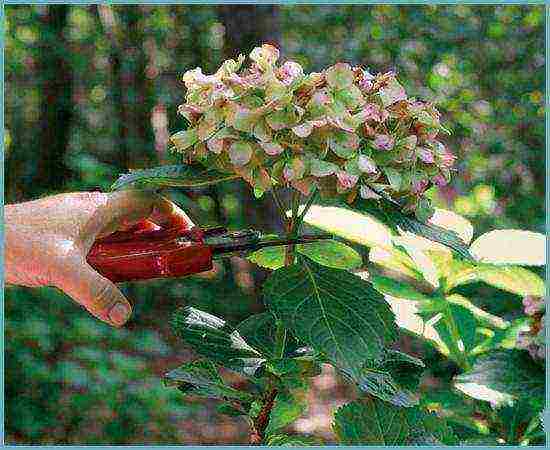
Fading flowers must be cut off so that they do not pull strength from the plant.
A perennial needs proper pruning. The plant should be pruned in the spring before the beginning of the growing season, removing old shoots and leaving young and strong ones, shortening them by 3-5 buds. Faded and dried bush inflorescences must be removed. Old perennial bushes must be cut almost at the root, leaving only low stumps, from which young shoots will develop.
Fertilizing and fertilizing hydrangeas
The hydrangea planted in prepared and fertilized soil for the first two years can not be fertilized or fed.
Then the procedure for feeding hydrangeas is as follows:
- in the spring, it is necessary to apply a complex fertilizer containing micro- and macroelements (phosphorus, potassium, nitrogen) under each bush;
- the second time in a season, top dressing (potassium sulfate together with superphosphate) is applied during the period when buds appear on the bush;
- a couple of times it is advisable to feed the perennial with diluted chicken droppings or cow dung.
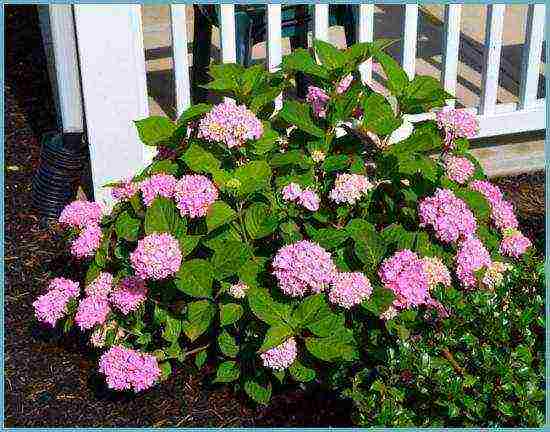
Hydrangea responds very well to feeding
Caution: Excessive fertilization of nitrogen can lead to greening of hydrangea petals and problems with the wintering of the plant.
It should also be borne in mind that hydrangea responds well to lactic acid, therefore it is important when growing it to periodically water the bush with soaked sour bread, milk whey, sour milk, kefir.
Propagation of hydrangea
Like other perennial shrubs, hydrangea can be propagated vegetatively (by cuttings, dividing the bush, layering) and seeds.
To grow shrubs from cuttings, it is necessary to cut the tops of young non-lignified shoots in mid-July and root them in specially prepared soil, consisting of coarse sand and peat. Experts recommend taking measures to increase soil moisture under the cuttings. For this, sphagnum moss is added to it. Cuttings are planted in such soil a little at an angle, at a small (up to 5 cm) distance and provide them with a temperature regime in the range of 16-20 ° C. For rooting, 4-5 weeks are enough. After that, the hydrangea is planted in a permanent growing area and provided with proper care.
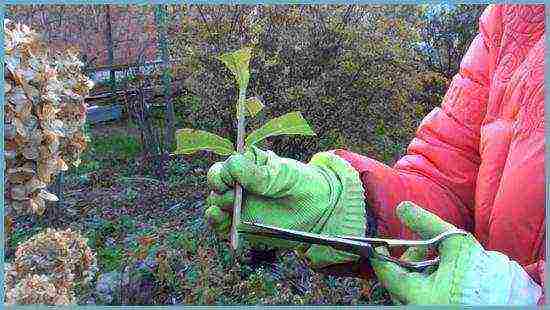
Propagation of hydrangea by cuttings
When the hydrangea propagates by dividing the bush, part of it is separated, while it is important that there are 2-3 buds on the young shoots, they are dug up and transplanted to a new place.
For the propagation of hydrangeas by layering, it is necessary to bend one of the young shoots of the growing bush to the ground and dig it into a previously dug hole (up to 15-20 cm deep). In order to prevent the shoot from straightening, it can be fixed with staples. Experienced gardeners recommend making an incision on the part of the shoot that will be in the ground to speed up the rooting process. It is necessary to regularly water the branch, it can also be mulched.After the formation of its own root system at the branch, it is separated from the mother bush and planted in a new place.
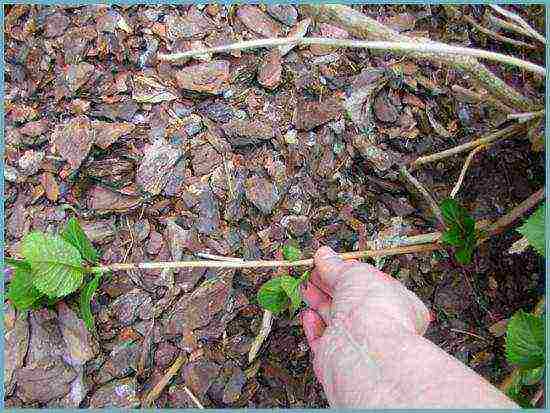
Propagation of hydrangea by layering
Diseases and pests
As a rule, hydrangea is quite resistant to all sorts of pests and diseases. However, it can also become infected with chlorosis, downy mildew, spider mites, and green leaf aphids can appear on it.
Chlorosis is expressed in a sharp lightening of the leaves of the plant, the loss of their natural color. The reason for its development is the excessive content of lime or humus in the soil. To eliminate chlorosis, it is enough to water the plant with solutions of nitric acid potassium and copper sulfate in turn with an interval of three days.
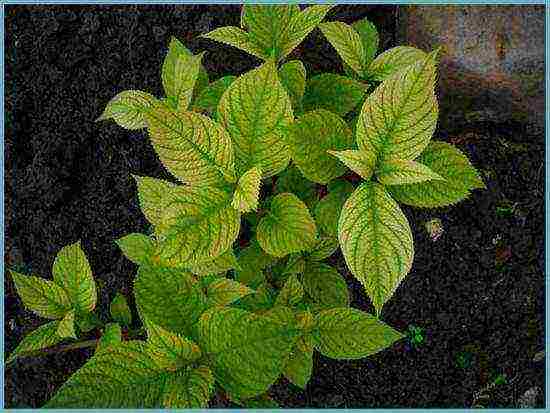
Hydrangea disease - chlorosis
The cause of hydrangea disease with downy mildew is excess air humidity. For treatment, it is recommended to treat the hardwood surface with a solution of copper sulfate with the addition of soap.
Garlic infusion will help drive aphids from the plant. It is necessary to prepare a garlic infusion (200 g of chopped garlic in a bucket of water, let it brew for 2 days), add laundry soap (40 g) and irrigate the perennial with this infusion every 5-7 days until the aphids are destroyed.
Hydrangea: combination with other plants
In a flower garden or garden, hydrangea is quite effective both by itself and in combination with other flowers. For example, panicle hydrangea looks great next to clumps of purple-leaved barberries, viburnum vesicle. The beauty of the tree-like hydrangea is emphasized by daylilies, sheared barberry, undersized juniper.
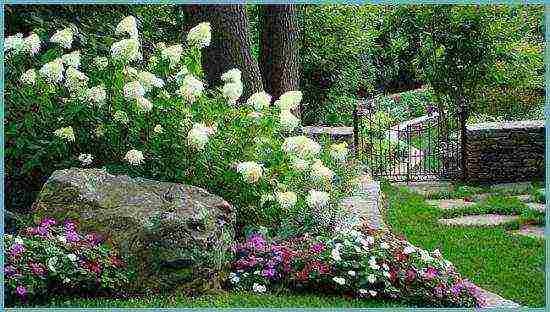
Hydrangea in the design of the flower bed
Hydrangea in landscape design
Hydrangea is a fantastically beautiful flower that inspires beautiful compositions in landscaping. Taking into account the climatic conditions, in our latitudes it is recommended to plant a tree-like, paniculate and petiolate hydrangea. Hydrangea looks magical in the photo in large compositions when it grows in the squares, surprising everyone with the size and beauty of its inflorescences. To emphasize the beauty of hydrangea, you can surround it with borders of spirits, cotoneaster, and other shrubs. The hydrangea should be planted in a flower garden in the background so that it does not obscure other plants.
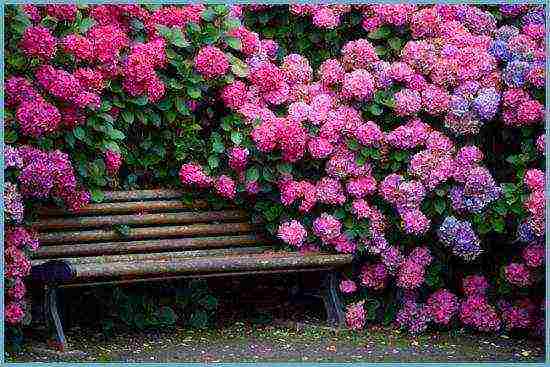
Hydrangea in landscape design
It is not recommended to combine hydrangea with yellow, red, orange flowers. Plants with bluish flowers, needles or leaves can successfully shade a shrub - for example, clematis, cereals, hosts, stunted junipers.
A classic landscape design is the combination of hydrangea with pink phlox with a round shape of inflorescences, thujas, microbiota. Also hydrangea is used in mixborders to create compositions along garden paths, can be grown as a hedge.
Hydrangea is the basis of a beautiful garden. With proper care, it will delight you for years to come. Experiment with different varieties of this shrub, try to decorate your gazebo with climbing hydrangea, plant a tree-like one along the paths, create a living fence using a paniculata.
Garden hydrangea care: video
Garden hydrangea: photo
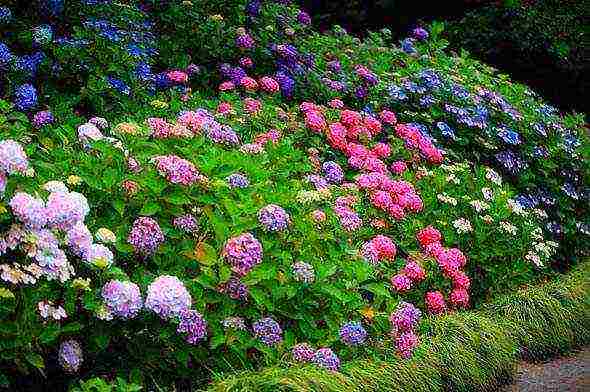
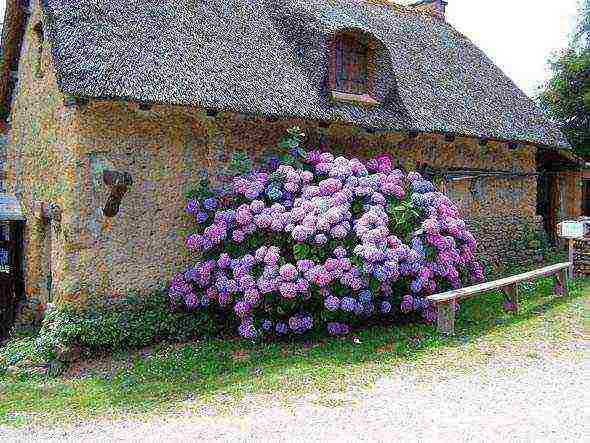
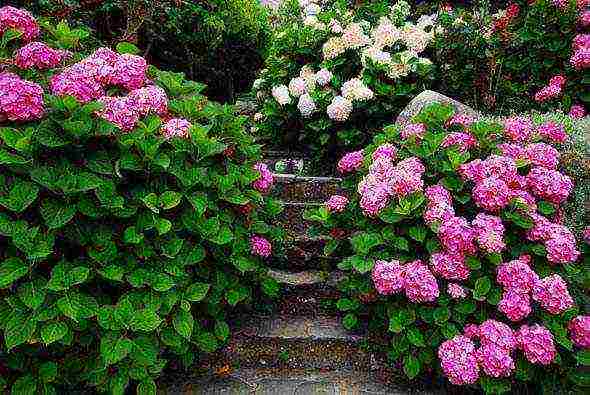
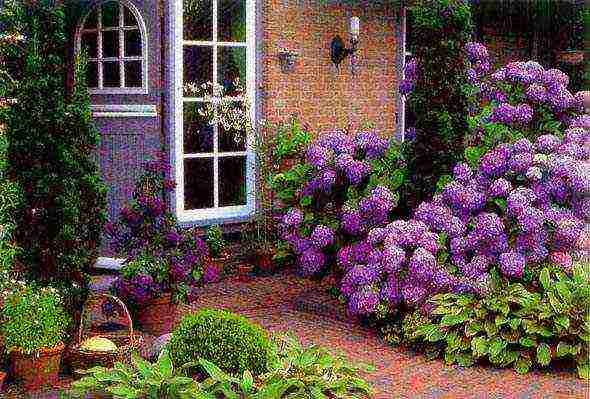
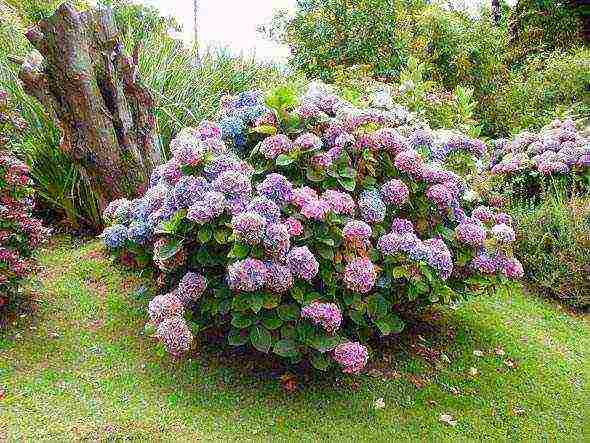
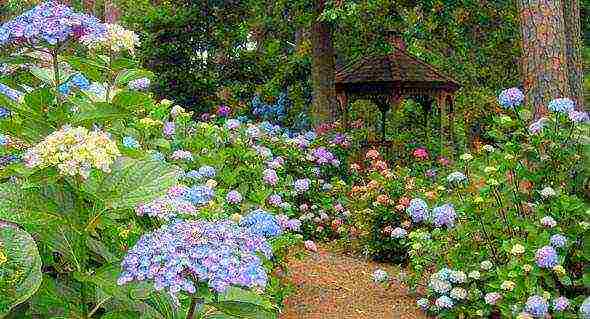
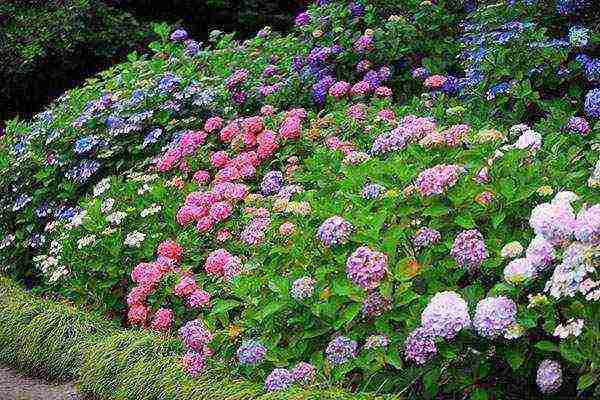 Hydrangea is a beautiful garden flower with fluffy multi-colored caps. They are represented by several types: by the type of shrubs up to 3 m high, small trees and vines that can braid a tree up to 30 m in height. The hydrangea will bloom from spring to frost, delighting with its globular inflorescences. However, there are species for which this time is shorter.
Hydrangea is a beautiful garden flower with fluffy multi-colored caps. They are represented by several types: by the type of shrubs up to 3 m high, small trees and vines that can braid a tree up to 30 m in height. The hydrangea will bloom from spring to frost, delighting with its globular inflorescences. However, there are species for which this time is shorter.
Hydrangea planting rules
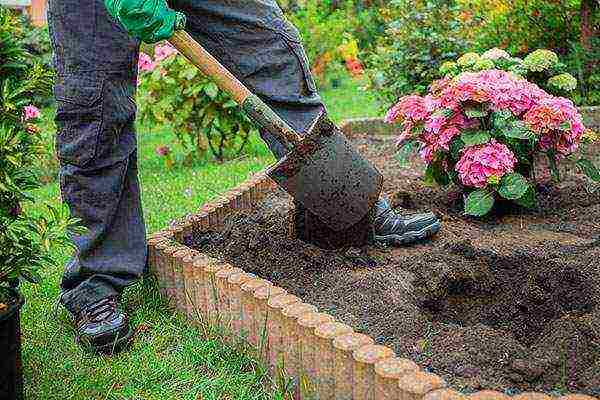 You can plant a hydrangea in early spring or fall. In this case, the first option will be preferable. For hydrangeas, you need to choose the right planting site. She prefers acidic soil with good moisture. With regard to lighting, these flowers can feel comfortable both in the sun and in partial shade.
You can plant a hydrangea in early spring or fall. In this case, the first option will be preferable. For hydrangeas, you need to choose the right planting site. She prefers acidic soil with good moisture. With regard to lighting, these flowers can feel comfortable both in the sun and in partial shade.
The whole planting process can be divided into several stages:
- It is necessary to dig a hole 40-50 cm deep and 40 cm in diameter. If the hydrangea bushes or outgrowths are small, you can make the hydrangea slightly smaller.
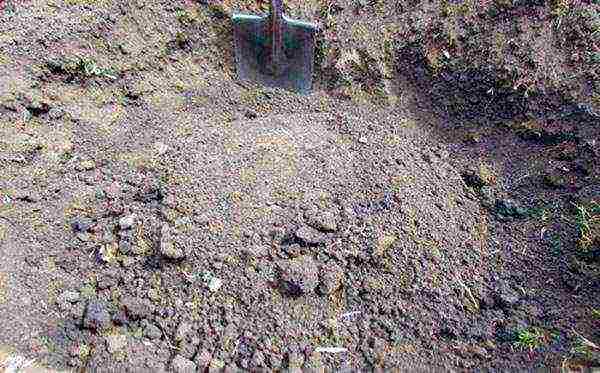
- Now you need to prepare a soil mixture consisting of fertile soil, humus and peat. It is advisable to add 50 g of mineral fertilizer to it. If possible, such a mixture is left in the pit for 15 to 30 days. If the soil at the planting site is rich and fertile, then the plant can be planted directly into it without prior preparation.
- The prepared seedling must be placed in the center of the planting pit so that its root collar is not deeply buried. Around the plant should be carefully covered with soil and tamped so that the roots are well pressed and there is no void around them.
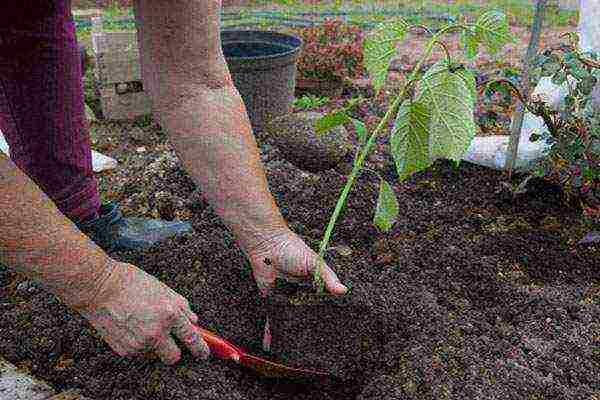
- The planted bush should be watered abundantly. It is advisable to additionally sprinkle the soil on top with sawdust, bark or peat.
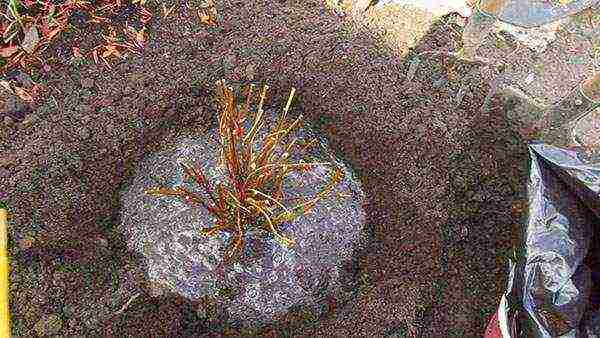
After planting a hydrangea bush, it is better to cover it from sunlight for a few days. This will allow the plant to take root faster. Hydrangea can be planted both singly and in groups. In this case, the distance between the bushes should be about 1 meter.
Basic rules for caring for hydrangea
Hydrangea care comes down primarily to proper watering, timely feeding, pruning and loosening. If you do everything right, the bushes will be lush, and the inflorescences will be large and bright.
Watering
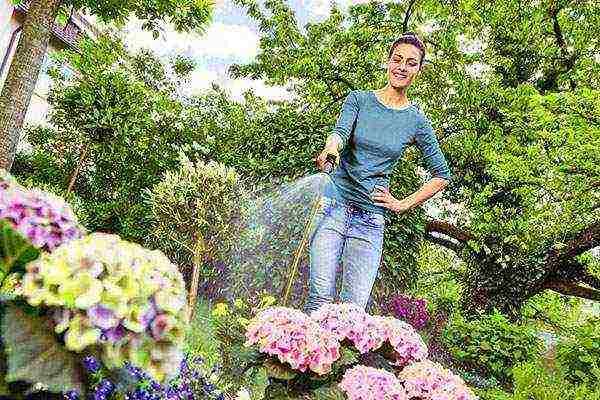 Hydrangea is a moisture-loving plant that requires frequent watering. It should be plentiful, 15 - 20 liters for each adult bush. In hot weather, this should be done once a week. In hot and dry summers, watering can be increased up to twice a week. In this case, you need to focus on the condition of the soil, given how quickly it absorbs moisture and dries out.
Hydrangea is a moisture-loving plant that requires frequent watering. It should be plentiful, 15 - 20 liters for each adult bush. In hot weather, this should be done once a week. In hot and dry summers, watering can be increased up to twice a week. In this case, you need to focus on the condition of the soil, given how quickly it absorbs moisture and dries out.
For watering, it is best to use settled soft water at room temperature. Periodically, you need to add a little potassium permanganate to it, which will prevent the appearance of rot. Water the hydrangea in the morning or evening, when it is not too hot.
Top dressing
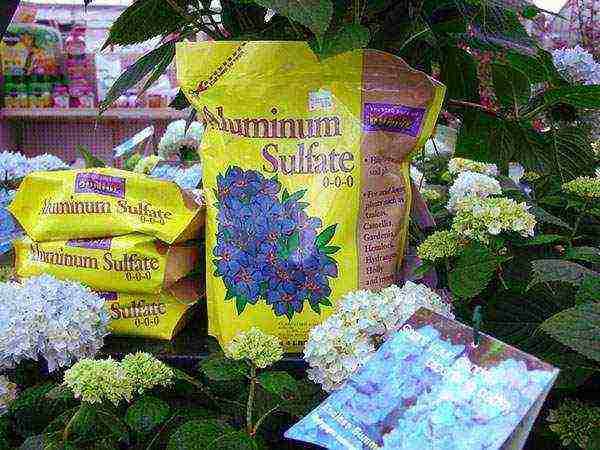 For good development and lush flowering, hydrangea needs to be fed. For this, both organic and mineral fertilizers are suitable. Their use is especially important during periods of intensive growth. You can buy ready-made fertilizers that are rich in magnesium and iron. Feeding in the form of a solution of poultry droppings with water in a ratio of 1:10 in combination with a mineral composition of 20 g of superphosphate, 10 g of nitrate and 10 g of urea has a good composition. You can use any slurry as a fertilizer, just observe the measure, otherwise the buds will be too large, which can cause fragile branches to break.
For good development and lush flowering, hydrangea needs to be fed. For this, both organic and mineral fertilizers are suitable. Their use is especially important during periods of intensive growth. You can buy ready-made fertilizers that are rich in magnesium and iron. Feeding in the form of a solution of poultry droppings with water in a ratio of 1:10 in combination with a mineral composition of 20 g of superphosphate, 10 g of nitrate and 10 g of urea has a good composition. You can use any slurry as a fertilizer, just observe the measure, otherwise the buds will be too large, which can cause fragile branches to break.
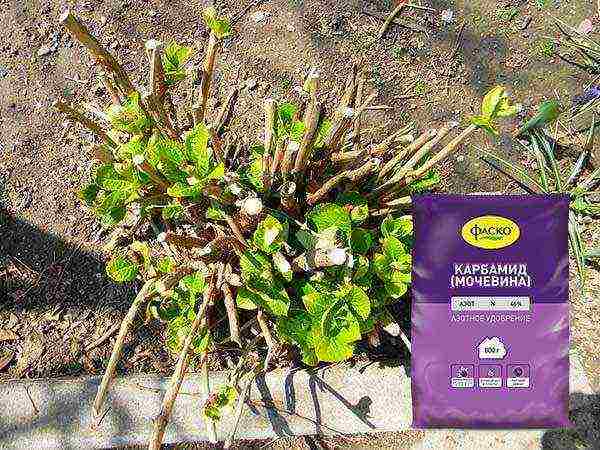 It is necessary to fertilize hydrangea not only during planting, but periodically as it grows. The first such feeding should be done at the end of May. It should be repeated after two weeks. You can fertilize flowers throughout the summer, but in August it is advisable to stop feeding so that the shoots can become woody for winter.
It is necessary to fertilize hydrangea not only during planting, but periodically as it grows. The first such feeding should be done at the end of May. It should be repeated after two weeks. You can fertilize flowers throughout the summer, but in August it is advisable to stop feeding so that the shoots can become woody for winter.
Mulching
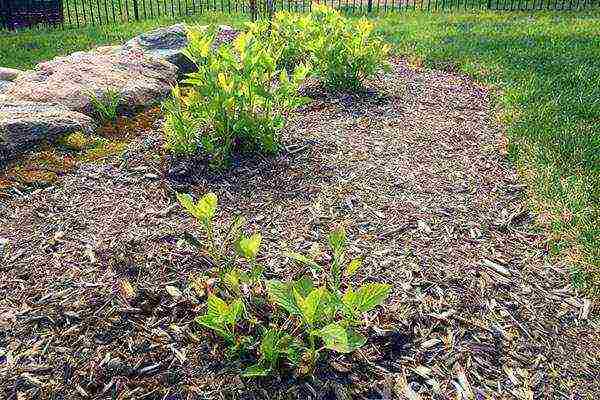 Thanks to the mulching of the trunk circle, the roots of the hydrangea will be protected from overheating and rapid growth of weeds. You must first make an organic mulch, consisting of wood chips or peat. It should be scattered evenly around the bush. This will help make the soil more acidic, which is what hydrangeas need. This mulch will gradually become part of the soil.
Thanks to the mulching of the trunk circle, the roots of the hydrangea will be protected from overheating and rapid growth of weeds. You must first make an organic mulch, consisting of wood chips or peat. It should be scattered evenly around the bush. This will help make the soil more acidic, which is what hydrangeas need. This mulch will gradually become part of the soil.
It is best to apply mulch under the bushes in late spring, when the soil is well warmed up. Mulching is also possible in late autumn, when temperatures are below zero. Periodically, the shrubs need to be loosened so that the soil is more moisture-permeable.
Pruning
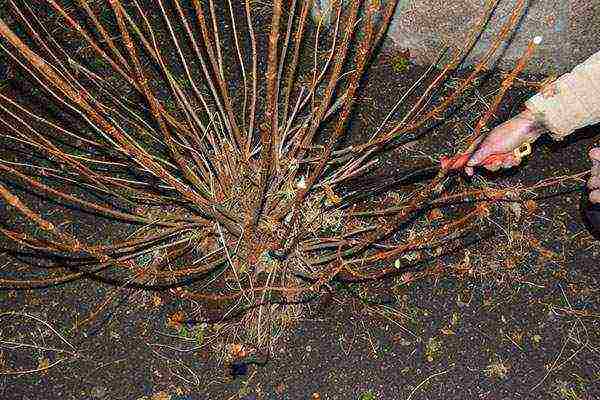 Pruning is done on plants that are 3 to 4 years old. This should be done in early spring - before sap flow and budding begin. If done too early, the cuttings will be unsuitable for further rooting, and if it is too late, the plant may die.This is why it is important to prune when the buds are just starting to swell.
Pruning is done on plants that are 3 to 4 years old. This should be done in early spring - before sap flow and budding begin. If done too early, the cuttings will be unsuitable for further rooting, and if it is too late, the plant may die.This is why it is important to prune when the buds are just starting to swell.
When pruning in mature plants, cut 3/4 of the height of each shoot with a pruning shear. In this case, 2 - 3 pairs of kidneys should remain on them. Old bushes can be renewed at the root. Everything will depend on the condition of the bush or tree. You need to cut off old or frozen shoots. During pruning, you can form a beautiful small tree with a certain shape. In the first year of the hydrangea's growth, its flowers should be removed. this will encourage more abundant flowering next year.
Preparing hydrangeas for winter
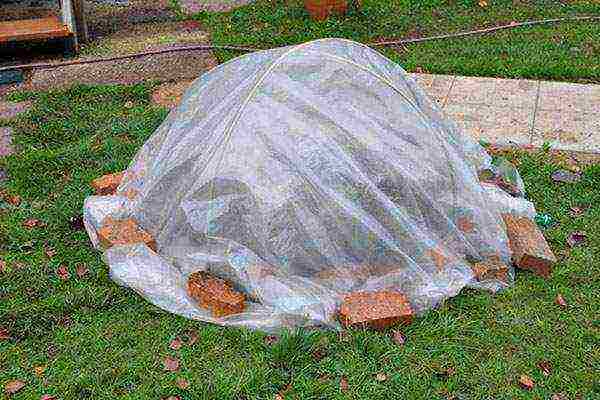 Hydrangea belongs to heat-loving plants, so it must be protected in the winter season. Young shoots and insufficiently winter-hardy varieties need special protection. If the bush is very young, you can simply cover it from above with earth, fallen leaves or sawdust. Older plants must be bent to the ground and covered with roofing material or lutrasil. To prevent the wind from blowing it away, you need to press down the covering material with bricks.
Hydrangea belongs to heat-loving plants, so it must be protected in the winter season. Young shoots and insufficiently winter-hardy varieties need special protection. If the bush is very young, you can simply cover it from above with earth, fallen leaves or sawdust. Older plants must be bent to the ground and covered with roofing material or lutrasil. To prevent the wind from blowing it away, you need to press down the covering material with bricks.
Mature bushes require more cover. We must try not to break them. The bush should be tied up, and then covered with spunbond or lutrasil, after which a frame of metal mesh or other materials at hand can be built around it. It should be about 20-25 cm away from the bush. The free space must be filled with dry foliage. Such an insulated frame will protect the hydrangea well even in severe frosts. You can remove it in the spring, when there is a stable above-zero temperature.
Propagation of hydrangea
Hydrangea is propagated in several ways:
- Cuttings. Reproduction in this way is best done in mid-spring or early summer. One-year lateral shoots must be used as blanks. They should be about 10-12 cm long. Cuttings should be cut at right angles. From the bottom they need to remove the leaves.
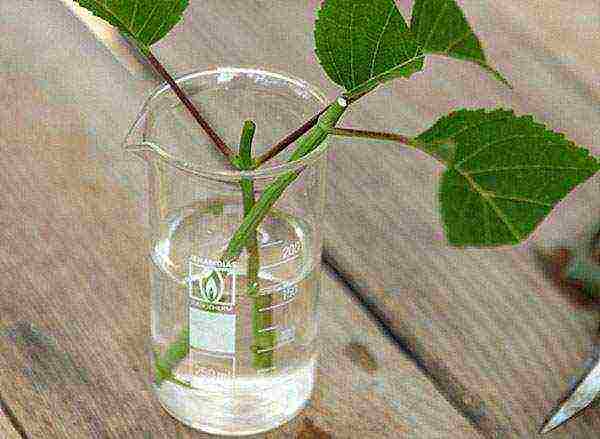 To root cuttings, you need to prepare the soil. For this, a light substrate is used, consisting of fertile soil, peat and sand.
To root cuttings, you need to prepare the soil. For this, a light substrate is used, consisting of fertile soil, peat and sand. 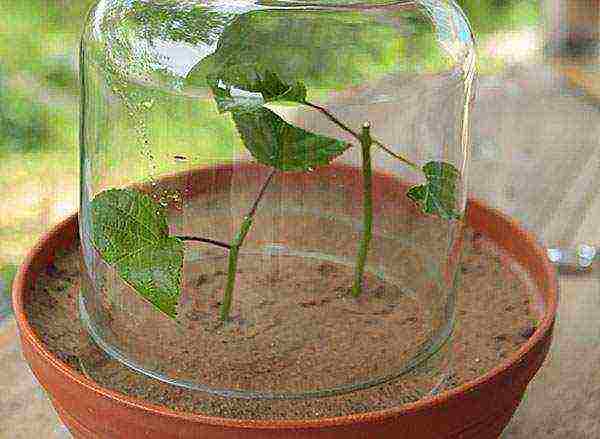 You need to plant cuttings in it, placing them at an angle. Each individual plant should be 5 cm apart. It will take about a month to root the shoots.
You need to plant cuttings in it, placing them at an angle. Each individual plant should be 5 cm apart. It will take about a month to root the shoots.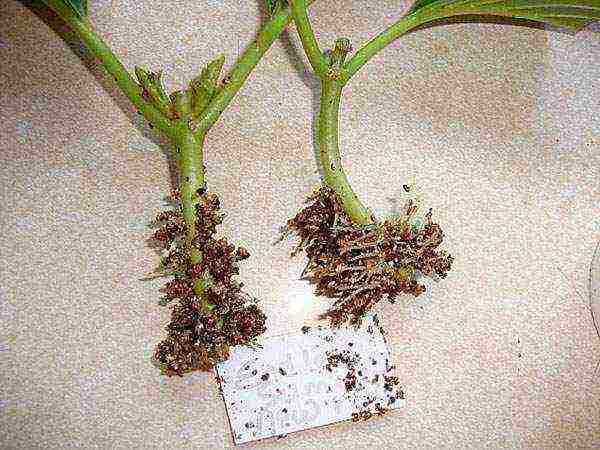
- By dividing the bush. It can be propagated both in spring and autumn. To do this, the plant must be dug up and divided into several parts so that each individual bush has a bud of renewal. After that, the plant is simply planted in the prepared places.
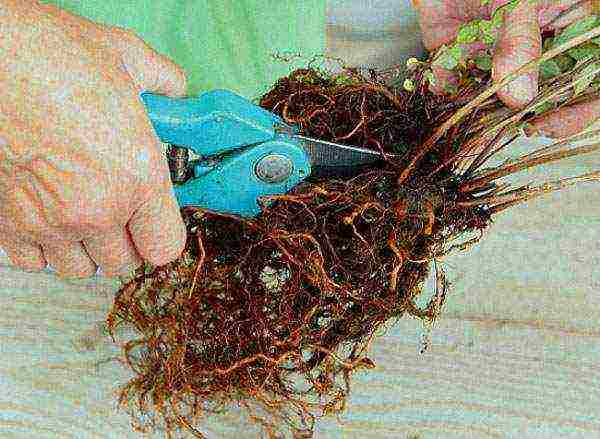
- Layers. For the propagation of hydrangeas by layering, you need to select young shoots, which will not be more than a year old. They should be bent to the ground and dug in so that a small top of 20 cm remains on top. The next year, the shoot will take root and it can be separated from the main bush and planted in another place.
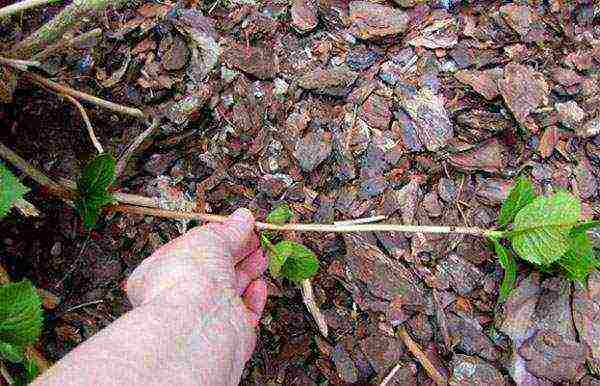
- Seeds. This is a rather troublesome process, so this breeding method is rarely used. The seeds need to be grown at home. To do this, they are planted in pots and only lightly sprinkled with sand. They need to be watered and fertilized frequently as they grow.
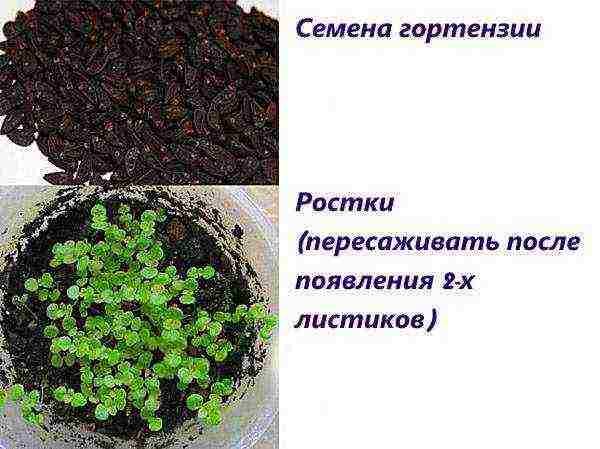
Popular types of hydrangea
Before planting a hydrangea, you need to decide on the choice of a suitable type. Each of them has its own growing characteristics that must be taken into account when planting and caring for. The most popular among gardeners: Large-leaved Hydrangea, Panicle Hydrangea, Petiole Hydrangea, Treelike Hydrangea.
Large-leaved hydrangea (Hydrangea macrophylla)
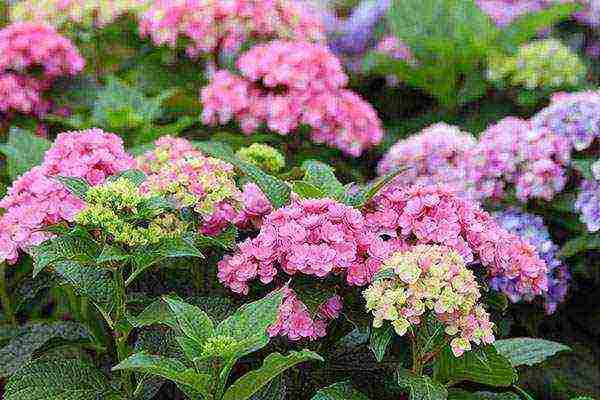 It will delight with flowering in July-August. This hydrangea has bright, dense foliage. The shoots of the current year look herbaceous, which is why the plant has a low cold resistance. Flowers have an umbrella shape. They can have different colors depending on the variety, the intensity of which depends on the acidity of the soil. The more acidic it is, the brighter the hydrangea will be. The height of the bush reaches up to 2 m.
It will delight with flowering in July-August. This hydrangea has bright, dense foliage. The shoots of the current year look herbaceous, which is why the plant has a low cold resistance. Flowers have an umbrella shape. They can have different colors depending on the variety, the intensity of which depends on the acidity of the soil. The more acidic it is, the brighter the hydrangea will be. The height of the bush reaches up to 2 m.
Hydrangea paniculata (Hydrangea paniculata)
 Blooms from mid-summer until the onset of cold weather. Inflorescences of this type have a pyramidal shape. They can reach a length of up to 30 cm. Panicle hydrangea grows in the form of a shrub, which can reach a height of 5 m or in the form of a small tree up to 10 m. This species is considered more frost-resistant and unpretentious.
Blooms from mid-summer until the onset of cold weather. Inflorescences of this type have a pyramidal shape. They can reach a length of up to 30 cm. Panicle hydrangea grows in the form of a shrub, which can reach a height of 5 m or in the form of a small tree up to 10 m. This species is considered more frost-resistant and unpretentious.
Stalked hydrangea (Hydrangea petiolaris)
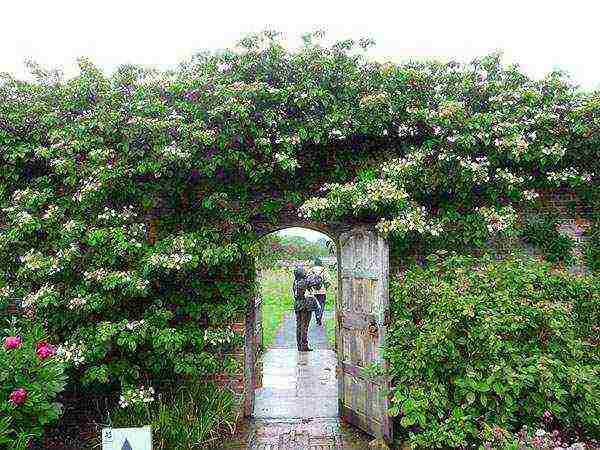 It is a shrub vine. It will require an additional support to which it will be attached with air suction cups. In length, it grows up to 25 m. This is a suitable species for planting near arches and arbors. Inflorescences have a corymbose shape up to 25 cm in size.
It is a shrub vine. It will require an additional support to which it will be attached with air suction cups. In length, it grows up to 25 m. This is a suitable species for planting near arches and arbors. Inflorescences have a corymbose shape up to 25 cm in size.
Hydrangea tree (Hydrangea arborescens)
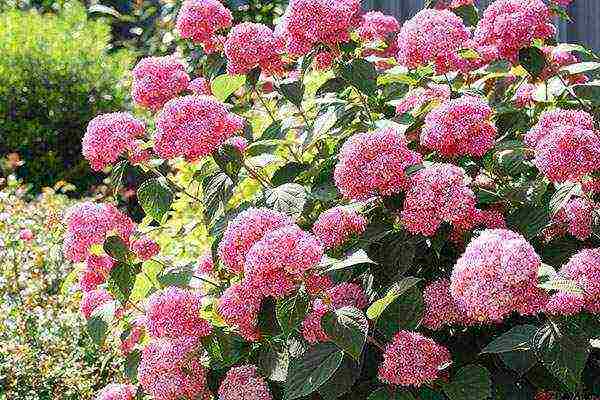 It grows up to 3 meters in height. The flowers are predominantly white or cream in color. There are several varieties of this species, differing in different colors. In winter, the plant can freeze slightly, so it must be carefully wrapped. In April, the bushes need to be heavily pruned. The flowers grow in large fluffy inflorescences.
It grows up to 3 meters in height. The flowers are predominantly white or cream in color. There are several varieties of this species, differing in different colors. In winter, the plant can freeze slightly, so it must be carefully wrapped. In April, the bushes need to be heavily pruned. The flowers grow in large fluffy inflorescences.
Ground cover hydrangea (Hydrangea heteromalla)
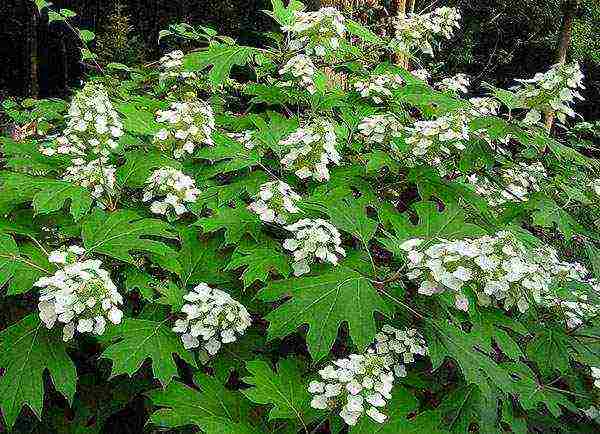 It is also called the Bretschneider hydrangea. This species is considered hardy and unpretentious. The bush reaches 2 - 3 m in height. The inflorescences are corymbose. At first they are white, and at the end of flowering they turn pink. Such a hydrangea blooms in the middle of summer.
It is also called the Bretschneider hydrangea. This species is considered hardy and unpretentious. The bush reaches 2 - 3 m in height. The inflorescences are corymbose. At first they are white, and at the end of flowering they turn pink. Such a hydrangea blooms in the middle of summer.
Recommendations for planting and caring for hydrangea in the garden - video


